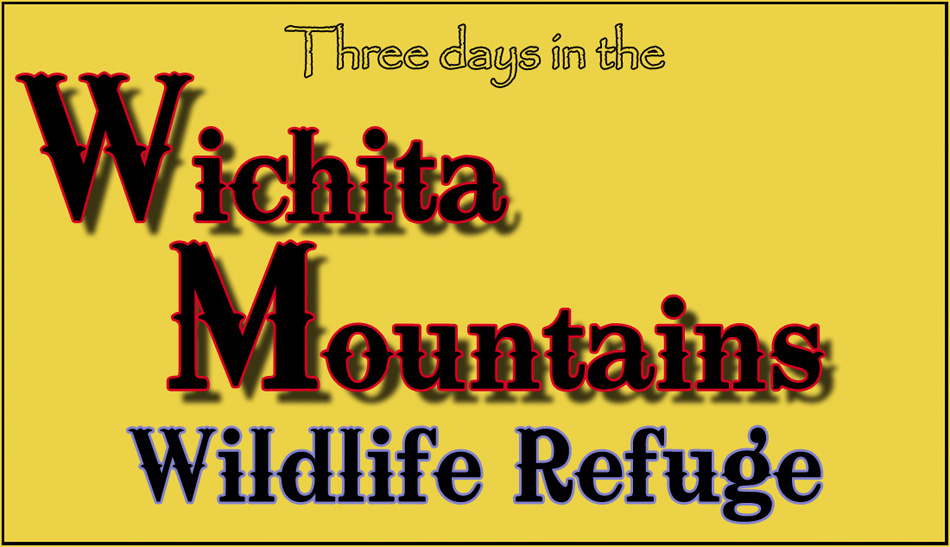
|

|
A Bit of Background
My association with the staff of the Savannah National Wildlife Refuge in Georgia has paid dividends in many unique ways. In essence, this article is the result of another outreach from that association… In July of 2009 I was in Savannah on a business trip. Along with my friend Fitz Clarke, we were invited to attend and photograph a Wood Duck banding session at the refuge. These events always commence pre-dawn and we were at the assembly point around 0500 hours. This session was attended by an Assistant Fire Management Officer on loan from Oklahoma to the refuge for a time. This was my first introduction to Rob Wood, his wife Ms. KK and daughter Abigail, who came along for the banding session as something out of the ordinary. Rob and I talked about his being in Georgia and his refuge in Oklahoma. Eventually I indicated I was intrigued by his description of the site and would like to visit to do some photography. He told me to come on out – I in turn stated that he should be careful because we had a project pending in Missouri and the drive time from there was within reach to his facility – I may just show up on his doorstep… In the end result, this is just what happened. In late September I availed myself of the opportunity to visit the Wichita Mountains Wildlife Refuge and it was an outstanding experience…

|

|
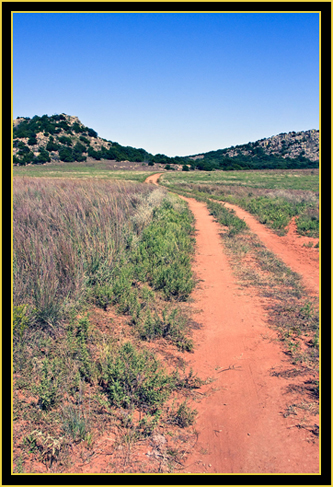


|

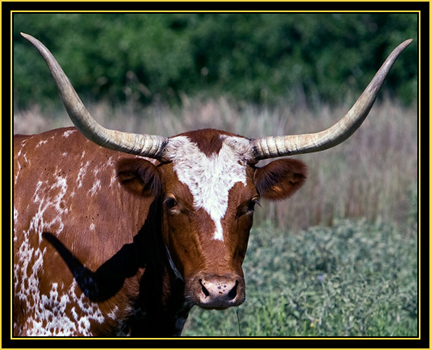
|
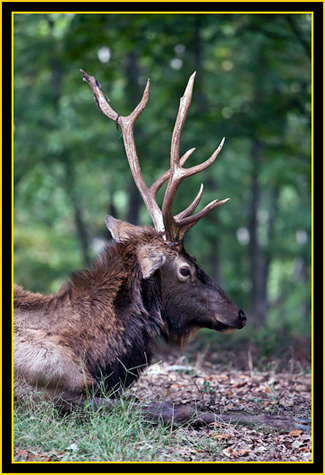
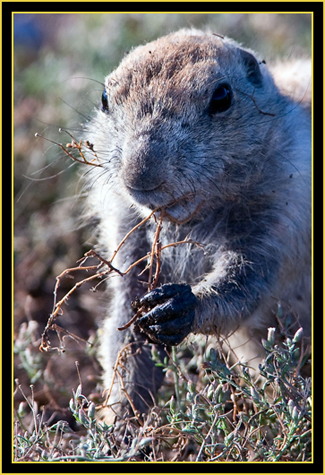

|
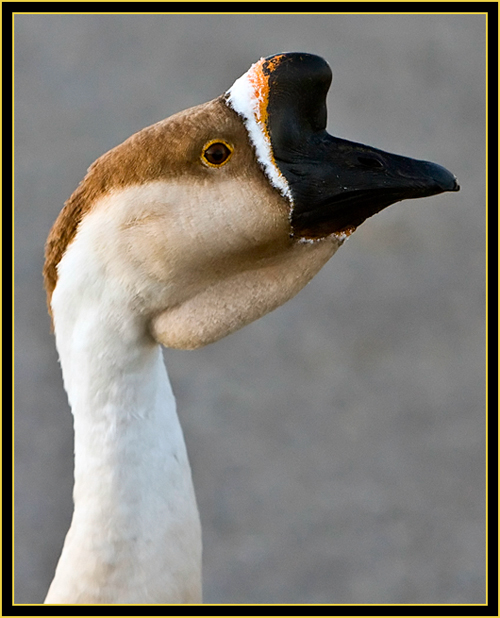
|
I drove into Lawton on a Thursday, arriving late in the afternoon. After finding Rob’s home and greeting his family, Rob and I took a ride around town and he showed me some of the sights. I was pleased to find some Scissor-tailed Flycatchers - the state bird of Oklahoma, at a park we visited and I took some handheld shots. These would have been okay if I didn’t have an opportunity to obtain others but they were exposed in twilight at a high ISO rating, exhibiting a good deal of noise. I was especially interested in these beautiful birds as it would be a new addition to my Bird Photography Index and fortunately, we viewed others in the coming days. There were also a group of semi-domesticated birds around the pond and I took a few images as some of these were rather different including the subject at left. |
We discussed a plan for the morning - what time sunrise occurred, the drive time to the refuge, etc., as we wanted to be positioned early to obtain some sunrise exposures. I left it to Rob’s judgment as where to locate this first morning as I’d never been in this
refuge before. I don’t recall exactly what time we got up and on the road but it was early, really early… As a matter of fact we must have been in the refuge at French Lake nearly an hour before the sky started to lighten with the dawn. I told Rob we should take my vehicle
to the refuge for this morning’s drive rather than take a chance I may not pack a piece of equipment that may be required. There was an issue though, for some reason my truck heater wasn’t working at all having failed a day or two before in my travels. Needless to say it was
a cold, lengthy ride in and the last time we took my vehicle anywhere without the sun present… On the other hand, I didn’t realize at the time what amazing adventures were pending in the next few days…
Venus Rising over French LakeCanon EOS Mark III 1Ds on tripod, 1/25 second at 70mm; EF70-200 f/2.8L at f2.8, ISO 800 |
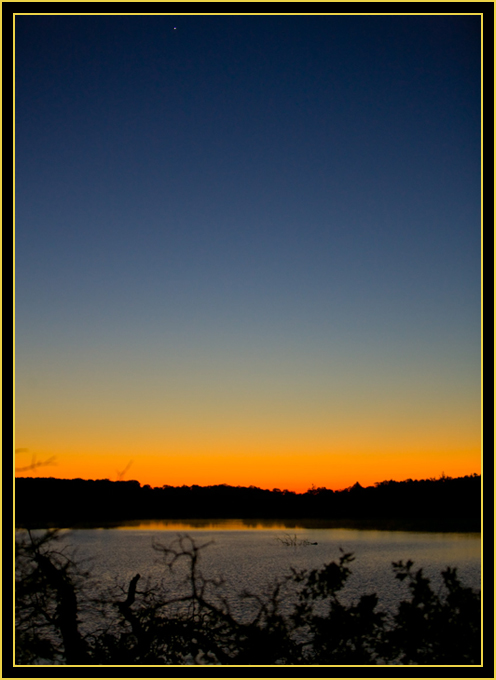
|
In the Field - Day One
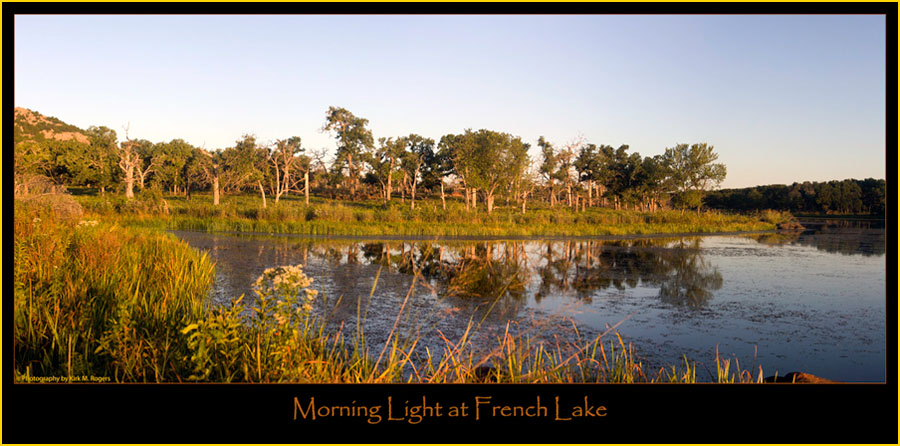
|
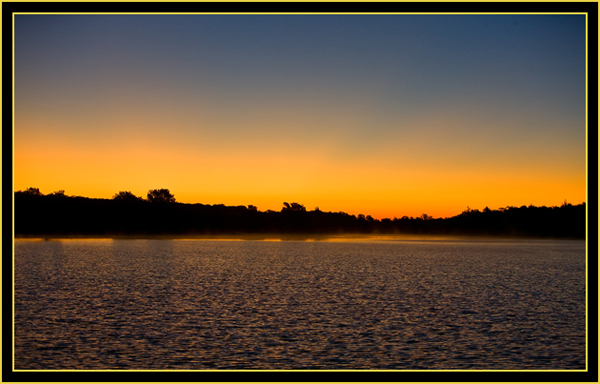
|
Although there were other locations we talked about visiting in the golden light of morning, we spent multiple hours at French Lake. It was the start of a beautiful day and my photographer’s eye viewed
many possibilities at this site. I had three cameras with me this
trip, two in the field at this time – the EOS Mark III 1Ds and a 5d. After several trips to my ‘camera bag’, aka my truck, we ended up with the 600mm f/4L lens on its dedicated tripod & Wimberley head
with a second carbon fiber tripod and ballhead for another camera and lens combination. All my digital cameras and lenses are from Canon.
Oklahoma SunriseCanon EOS Mark III 1Ds on tripod, 1/160 second at 70mm; EF70-200 f/2.8L at f/4.5, ISO 800 |
Dawn at French Lake - Wichita Mountains Wildlife Refuge
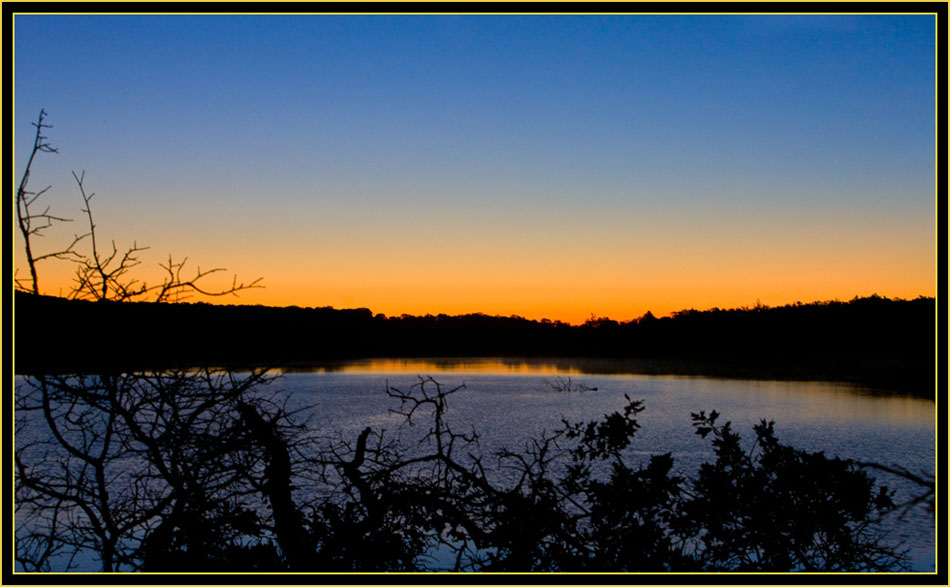
|
Mist on the Water as the Sun breaks the Treeline
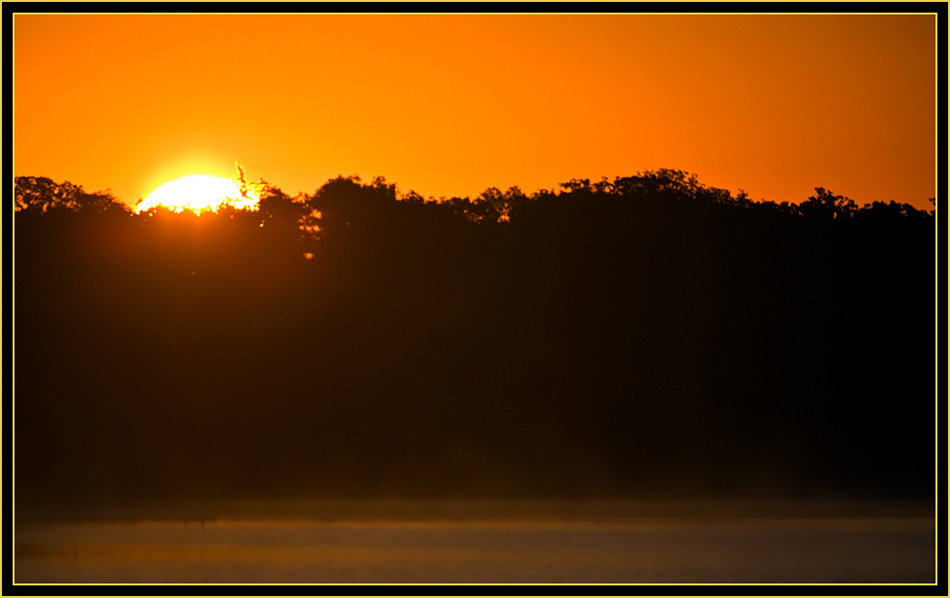
|
Rob's Beavers
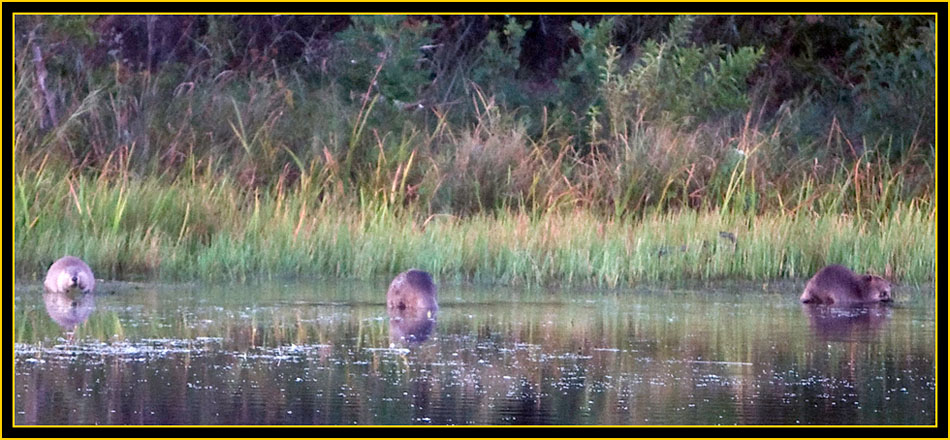
|
|
The refuge was coming alive and we were in a beautiful spot to see it all. Rob scanned the area constantly with binoculars and across the water from us near the opposite shore spotted three beavers nearly out of the water. He indicated surprise at this as
they aren’t often viewed unless swimming and then generally with only the head above water. I was pleased about this as well; I’d viewed beavers many times but hadn’t taken any good exposures of them. It was dim light requiring higher ISO settings but
this was enough to prompt getting the 600mm lens out of the truck to obtain a larger image scale. Rob, being the gentlemen that he is, went to the truck and carried this back. After I set it up however, I realized the 1.4X extender wasn’t on the lens
where I usually keep it, I almost never shoot this lens at 600mm and thought the extra reach of the extender was warranted, so after taking multiple insurance shots I went back to locate it. Beavers, primarily nocturnal, are large semi-aquatic rodents. Comments about these animals in several refuges I’ve visited indicate they can be a nuisance due to dam construction and create water blockages in areas that can go so far as to alter the landscape. With a population estimated at one time around sixty million in North America by the late 1980’s this count had dwindled to an estimate of six to twelve million. They were extensively hunted and trapped as a commodity for a variety of determinations including clothing finery, fur and for glands used for perfume and medicinal purposes. Beaver at DawnCanon EOS Mark III 1Ds on tripod, 1/125 second at 600mm; EF600 f/4L at f5.6, ISO 800 with flash |
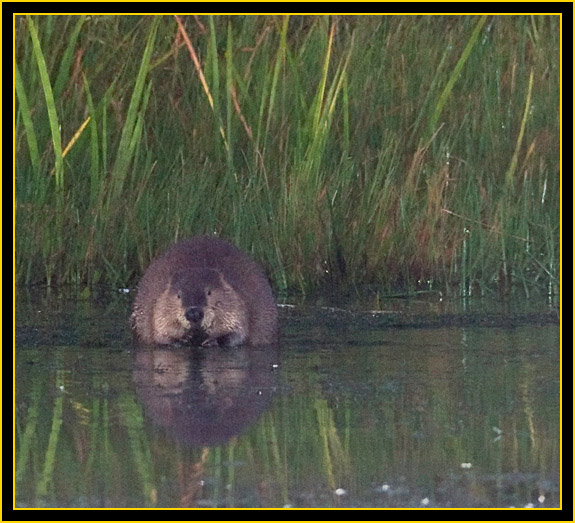
|

|
I could see easily enough this refuge would present multiple possibilities for exposures on a plethora of subjects. The landscape alone differed significantly from other areas I’d frequented – after all, isn’t this a primary reason for traveling? I didn’t
know at this juncture just how extensive this refuge was in diversity but I could tell there was going to be a good deal of computer time coming up in the immediate future conducting image evaluations… Even at this early stage of the visit I’d taken many
exposures and the day was young… I wish I could post more images to this journal to provide a larger sampling of what we viewed however, it would be far too long so I'm pacing myself. You can take my word in that what you will view with this article is a small percentage of the digital capture from the
Wichita Mountains Wildlife Refuge in my short visit.
Rob on the Lookout - French Lake |
Swimming Beaver
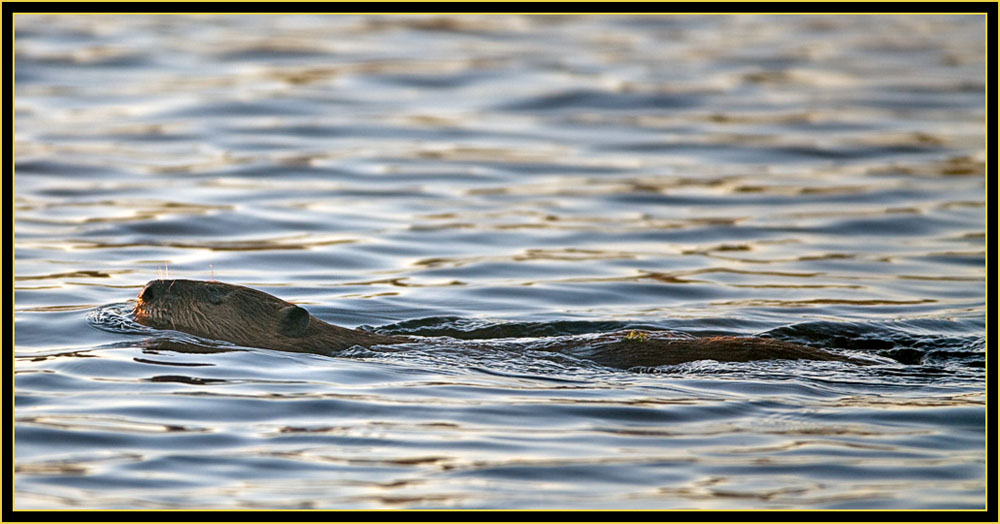
|
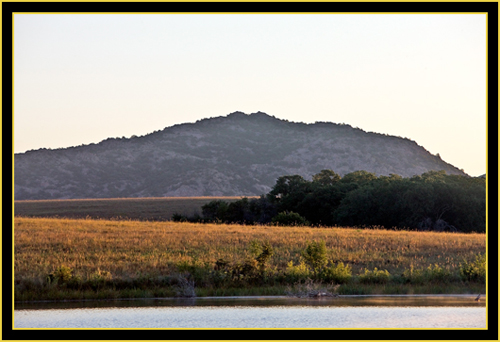
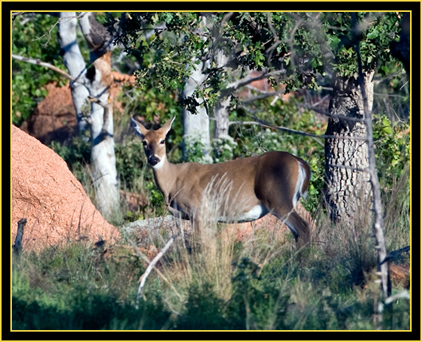
|
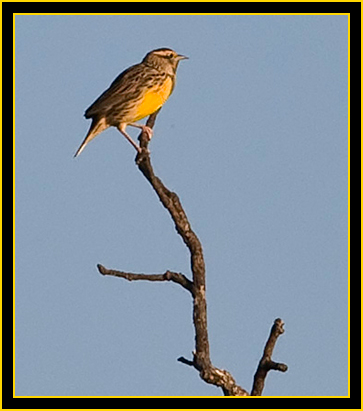
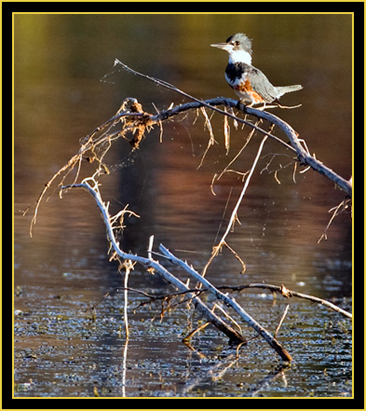
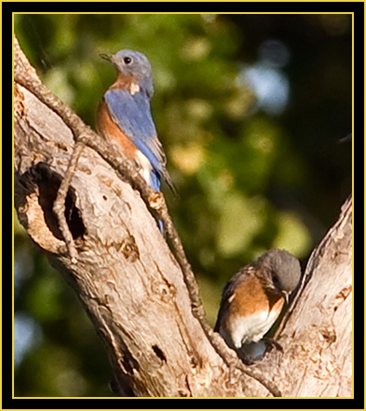
|

|
|
Rob suggested we next trade vehicles, picking up one of the facility’s heavy duty trucks so we could go ‘behind the fence’ – into the special use portion of the refuge which doesn’t have public access. I felt privileged being able to visit these areas so it was okay with me
and soon enough we were reloading the gear for the next part of the day. I don’t recall exactly what time it was but can ascertain a fair idea from the metadata on the shoot files, which record in order for each individual camera. It was around 0930 hours when we re-geared for
the next phase. I learned that there are multiple offices around the refuge to suit various purposes. Rob is a fireman and had his offices & staff situated in a separate building on the grounds; there was also a refuge headquarters which we visited later and a large Visitors Center with interpretive
displays, a gift shop and an excellent theatre to view the introductory film most of these offer. I later watched this film and found it quite informative and interesting.
While in the compound as Rob was fueling the truck I had the pleasure of meeting Mr. Ralph Godfrey, Fire Management Officer for the refuge and Rob’s immediate supervisor. We talked for a few minutes as I explained what we hoped to accomplish during this visit and I thanked him for the opportunity to visit the facility. Ralph was great and indicated as a registered volunteer they had bunkhouses available if I ever wished to stay on the grounds - this was something he could arrange. An interesting idea indeed… Roadway Through the Wichita Mountains Wildlife RefugeCanon EOS 40d handheld, 1/1600 second at 55mm; EF24~105 f/4L at f/8, ISO 400 |
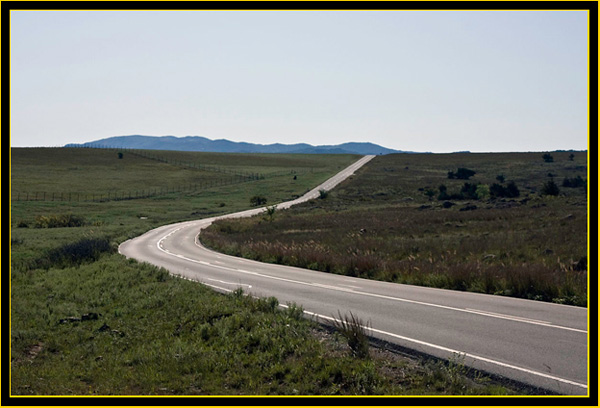
|
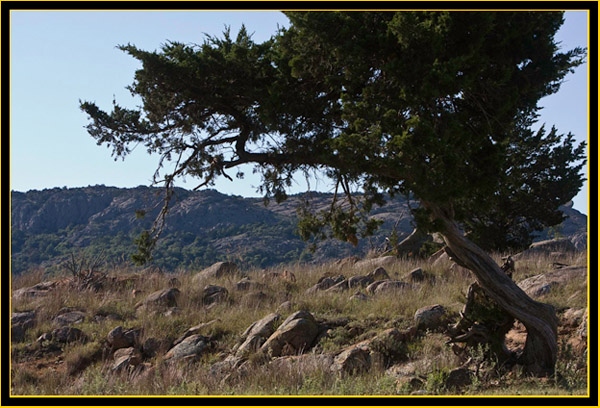
|
Once my travel plans were identified I’d emailed Rob asking if he wished to check with his associates to learn if there was anything in particular they may wish photographed while I was in the area. He did ask around and
one of the long term volunteers and ‘keeper of photographic archive’ at headquarters
had replied with a fairly comprehensive list of subjects and overall views. As we reviewed the list - and yes, we referred to this document as 'the list', I commented to Rob that I hoped he knew where to go for some of the
subjects as I had no knowledge of what some of the items were although I was impressed with the thought that went into this document. Most of the list was fairly typical though and
I planned to shoot both long and short focal lengths accordingly for birds, animals large and small, insects of all species, flowers, plants of varying types and of course the majestic landscape views. These subjects would
all draw my attention anyway so I felt we were good to go…
Gnarled Tree...Canon EOS 40d handheld, 1/250 second at 70mm; EF70~200 f/2.8L at f/10, ISO 400 |
The Fish & Wildlife Service had a fee based permit which was required if you were considered a professional photographer shooting in a federal reserve with the possibility that you would sell or otherwise commercialize your efforts in some fashion. I believe this has all changed now but I’ve learned it’s best to communicate with the staff at any given facility to let them know you plan to be around. Much depends on the public/restricted layout, type of facility and what you're planning to do of course. This may not be as easy as one would think… These staff people are busy all the time and you would be just another individual of many taking up their valuable day, so it pays to come to the table with a reference and/or recommendation that you’re the ‘real deal’ both in what you’re doing and how you go about doing it. I’m fortunate in this regard these days and am known at the various refuges I frequent. If making a full blown effort with travel involved they generally know I'm coming, have an idea when I'll arrive and what my plans may be. As a registered volunteer I do my best to make a contribution to the facility and always follow up. I planned to do the same at the Wichita Mountains Wildlife Refuge.
Soon enough we had passed through the gate stopping long enough to re-lock the chain and were traveling the gravel road. We had barely gone any distance before pulling off the road to have a look. The open landscape was beautiful and there was much to
investigate. One aspect we noted immediately was the wind was up. Not badly at first but later the wind became a detriment and precluded any type of macro work and almost did the same for general photography. Even the long lens although solidly supported became a wind barrier to the point it was
difficult to obtain a sharp exposure. I was photographing some insects on flowers and pulled out a Plamp from my camera bag – this device from Wimberley, Inc. has a clamp on each end. One attaches to the tripod and the other can
be used to hold the subject, in this case
stabilizing the flower stem in the wind. It can be bent to nearly any position and once in the desired orientation will retain that shape. Rob thought this was all pretty neat and took a few shots of me using it. At this stage the Plamp worked okay but as the wind
intensity increased we had to relinquish shooting close up. The insects we were photographing are known localy as Goldenrod Leatherwings (Chauliognathus pennsylvanicus). They are also known as Pennsylvania Leatherwings or Goldenrod Soldier Beetles...
Goldenrod Leatherwings on Leavenworth's EryngoCanon EOS Mark III 1Ds on tripod, 1/400 second at 100mm; EF100mm Macro f/2.8 at f/9, ISO 800 |
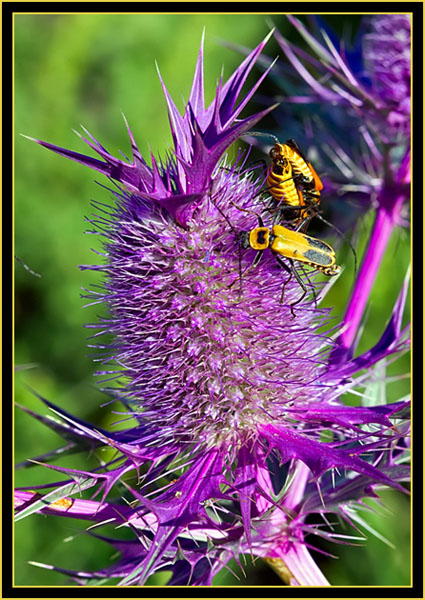
|
Macro Shooting - Rob's Views of Kiro using the Plamp


|
Macro Photography
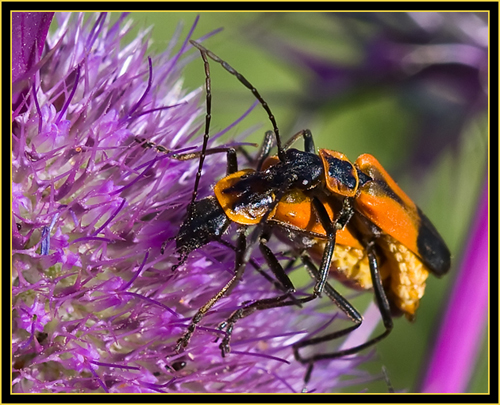
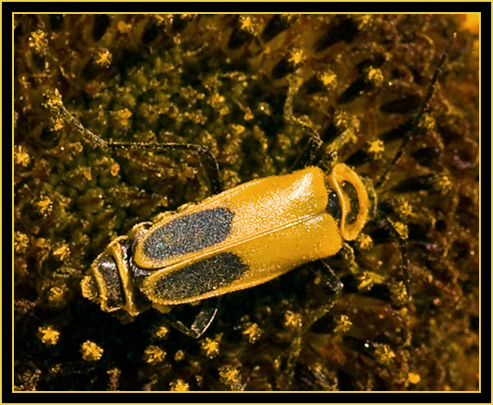
|
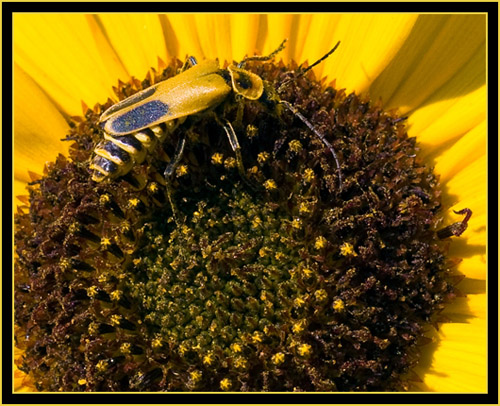
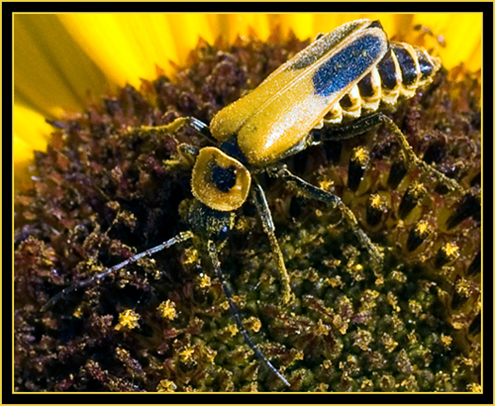
|
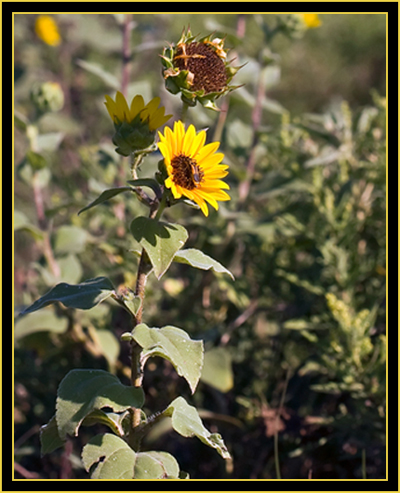
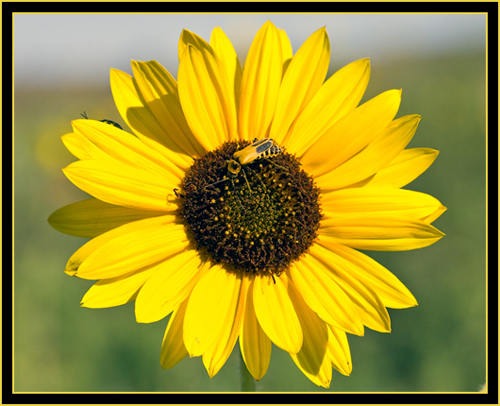
|
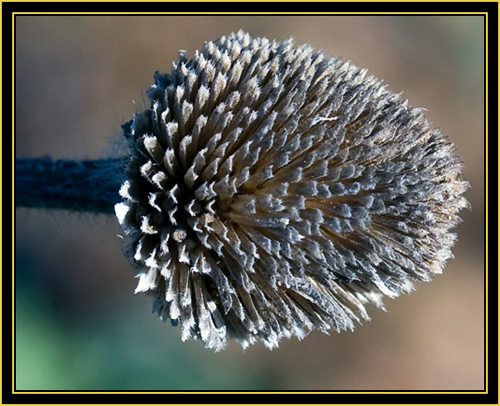
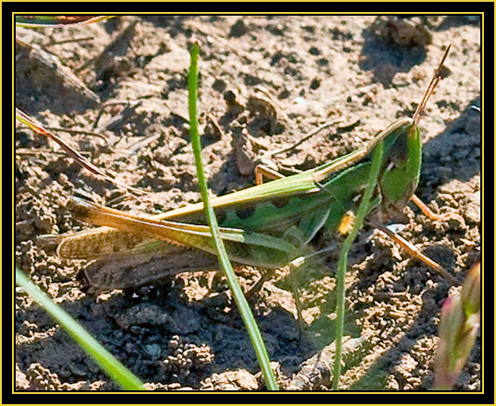
|
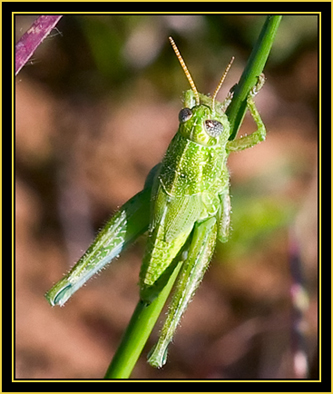
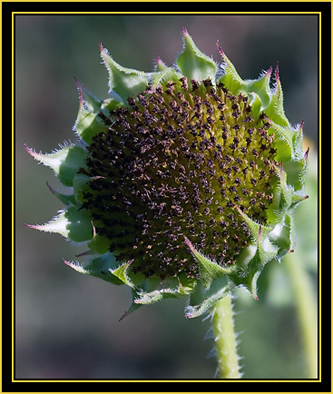
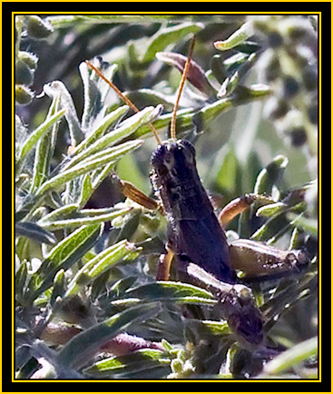
|
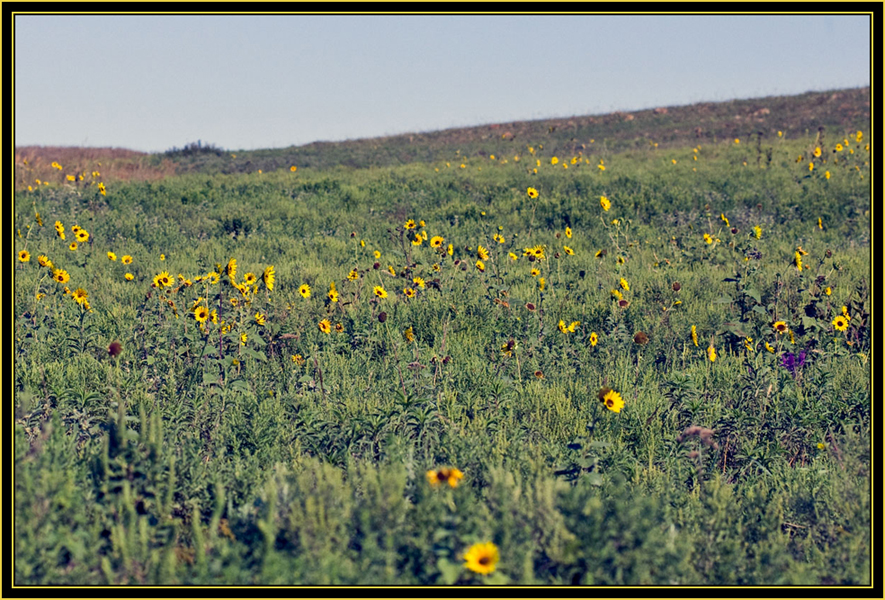
|
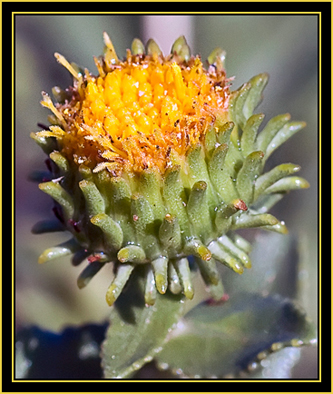
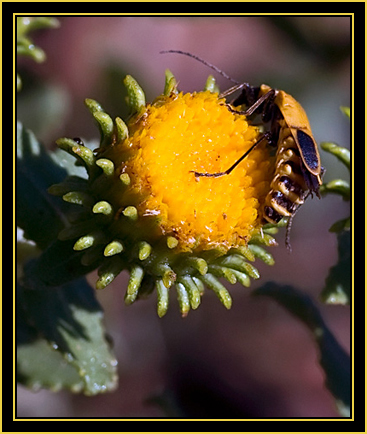
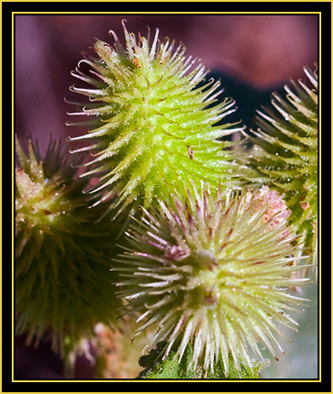
|
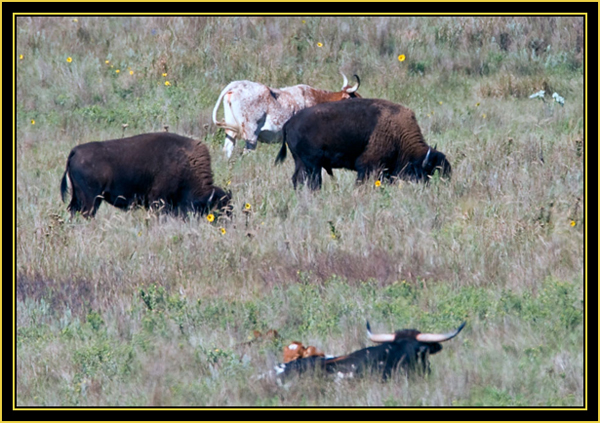
|
It was getting close to noon as we drove to an area Rob identified as Antelope Flats. He also named the various mountains in view but this information didn’t stay long in my memory. I thought this scene was interesting because the American Bison and Texas Longhorns were grazing together like one big, happy family as can be viewed in the image at left. This is most likely common in this refuge but nothing I’d viewed before. I shot several composite views of this beautiful scene. If you have the gumption to scroll back to the top of this page (or have a better memory than me and can recall) you can view one of these composite shots reduced for this article entitled, 'View of Antelope Flats'. This is a ten-exposure vertical composite which I printed and sent along to the Wichita Mountains Wildlife Refuge at full resolution. This may not mean much as you read this, but the final is 20 inches in height by seven feet, two-inches in length… I hope to return to the refuge one day to find this print displayed in the Visitors Center or in one of the offices…
American Bison & Texas Longhorns on Antelope FlatsCanon EOS Mark III 1Ds on tripod, 1/1000 second at 8400mm; EF600mm f/4L with 1.4X extender at f/8, ISO 800 |
Views Around the Flats
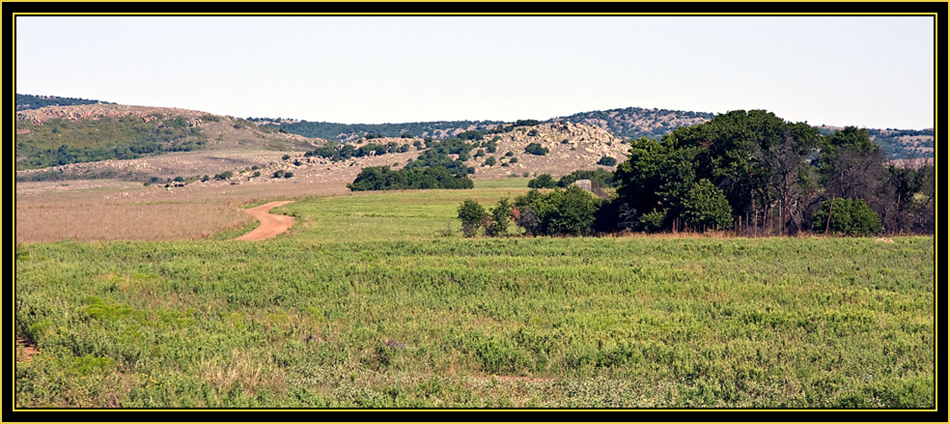
|
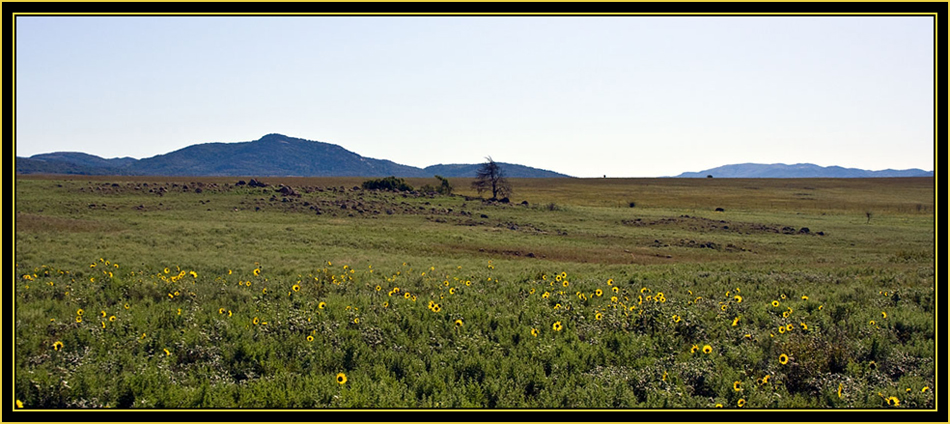
|
The day was getting warm – quite warm by Maine standards and soon this would be exacerbated as the sun climbed higher. I could just imagine what summer would be like in the Wichita Mountains as we drove the back roads. I had a single bottle of water in my vehicle when we left Lawton and that was long gone. We were so intent with what we were doing that taking a lunch break wasn’t really considered because we’d have to drive miles out of the refuge in order to do so. I learned the surrounding area is far from a metropolis by any stretch of the imagination, which lends more to the mystique and isolation of this beautiful area. I also learned that when Rob is on a mission he remains focused on the task at hand – no food, water or interruptions – I thought this was great until later in the day...
Plum Thicket DetailCanon EOS 5d on tripod, 1/1250 second at 120mm; EF70~200 f/2.8L at f/7.1, ISO 500 |

|

|
We started to see butterflies and occasionally dragonflies a few at a time. These are always on my shoot list so we kept an eye out for larger concentrations and movement to maximize possibilities on some of these
subjects. We’d already been chasing grasshoppers and other critters around the prairie for a time and kept moving along.
Indian Grass on the PrairieCanon 5d on tripod, 1/1600 second at 195mm; EF70~200 f/2.8L at f/7.1, ISO 640 |
Common Wood-Nymph Resting

|


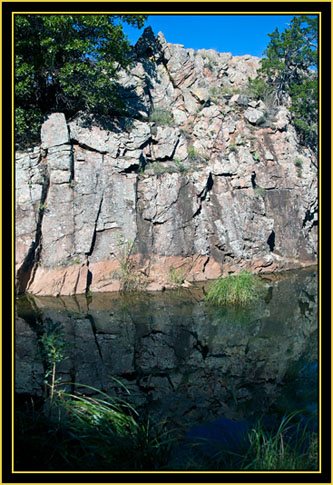
|

|
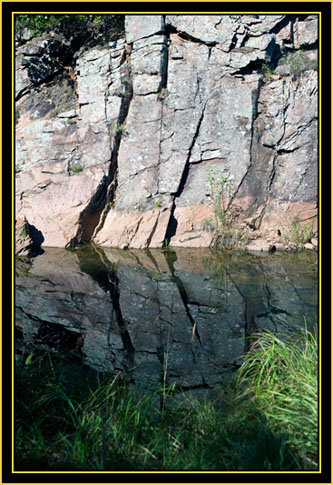


|
|
We came across this Longhorn Bull all by himself in a meadow and Rob stopped the truck so I could take a few shots. Although I considered approaching the animal to obtain a closer image, discretion appeared
to be the best recourse so I only went a few feet off the road and used a long lens. I figured there may be a good reason why none of the other longhorns wanted to hang out with him… I’d make a poor cowboy at my present knowledge level and
had Rob explain about cows, steers, bulls and calves as we traveled along.
Longhorns have been established in the Americas dating back to the early 1500’s with the Spanish exploration and settlement era. When the true longhorns were in danger of extinction in the 1920’s notice was taken and a plan developed to take action. By Congressional order and appropriation a small herd was gathered and transported to the Wichita Mountains Wildlife Refuge in 1927 - it was then known as the Wichita National Forest and Game Preserve. Since that period they have done well in the refuge. More about the history of longhorns and their presence in the refuge can be learned at the facility website. Texas Longhorn BullCanon EOS Mark III 1Ds handheld, 1/1000 second at 840mm; EF600 f/4L + 1.4X at f/8, ISO 640 |
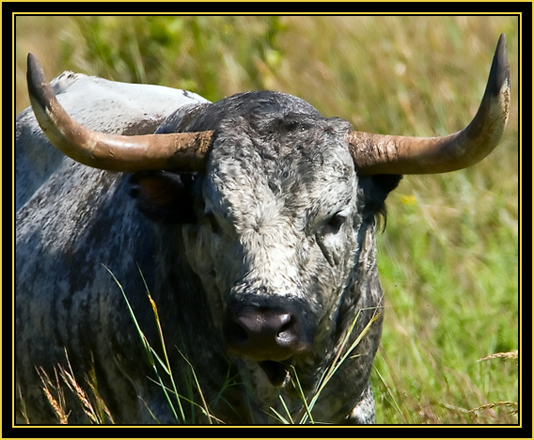
|
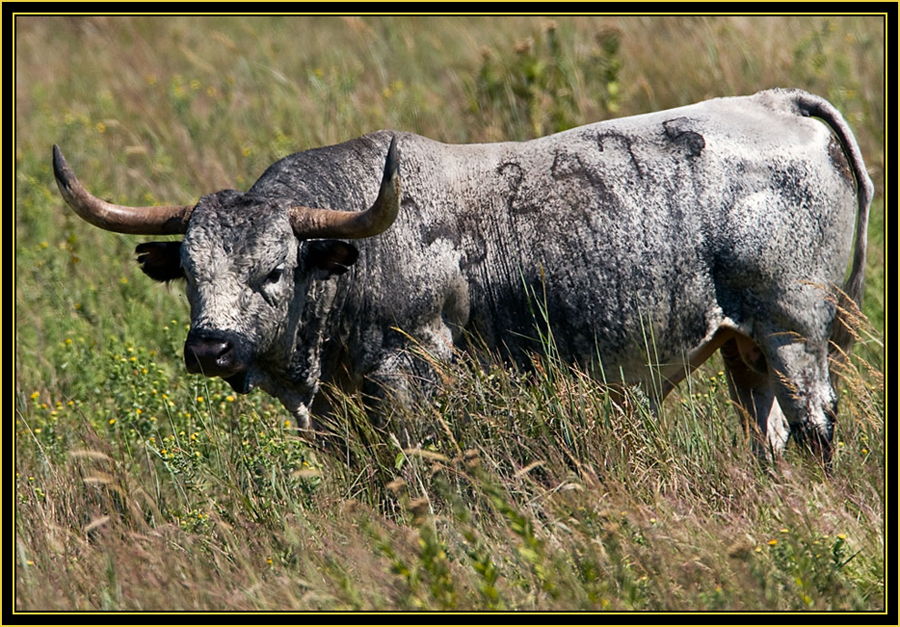
|
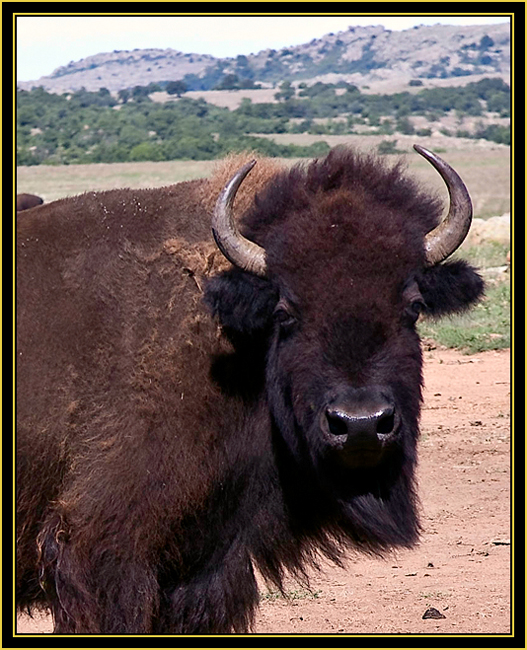
|
Shortly after seeing the Longhorn bull we came around a bend and found a group of American Bison near the road. We’d seen quite a few during the day but these were close and had young in the herd. Rob positioned the truck & shut
it down so I could shoot out the window from my side - they were close enough I didn’t want to get out as I’d be among them - a super telephoto lens wouldn’t have done much good at this distance in any event.
The American Bison (Bison bison), perhaps more commonly known as the buffalo, also has an exceptional history on the refuge. Most of us are aware that at one time millions of bison roamed the Great Plains - this estimate could have been as great as sixty-million animals. With indiscriminant hunting and slaughter, the refuge information indicates one would be lucky to count more than a thousand individuals by 1900. In 1907 fifteen bison were transported by rail to the refuge having been donated from the New York Zoological Society. This small herd comprised the nucleus of what can be found at the facility today. Rob stated the herd remains stable at around six-hundred individuals and they have an annual round up when bison are sold off for population control. The Texas Longhorns have the same type of round up, the purpose being to keep the numbers manageable for the available land in the facility. American BisonCanon 40d handheld, 1/320 second at 105mm; EF24~105 f/4L at f/7.1, ISO 400 |
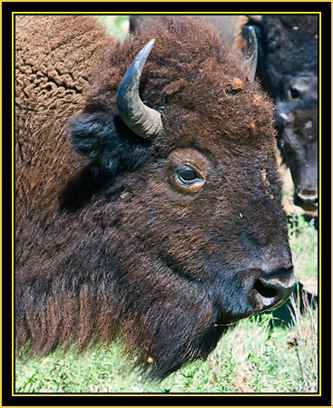
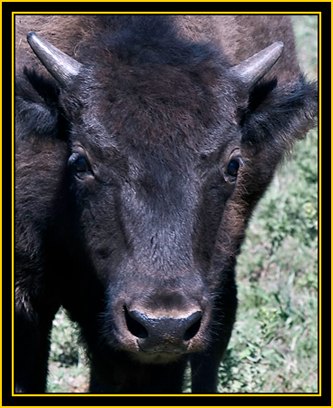
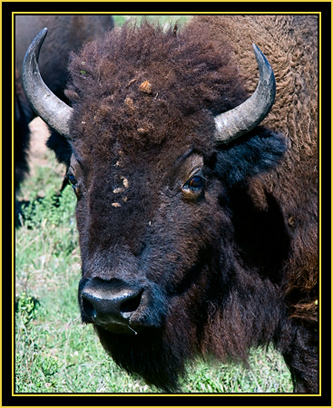
|

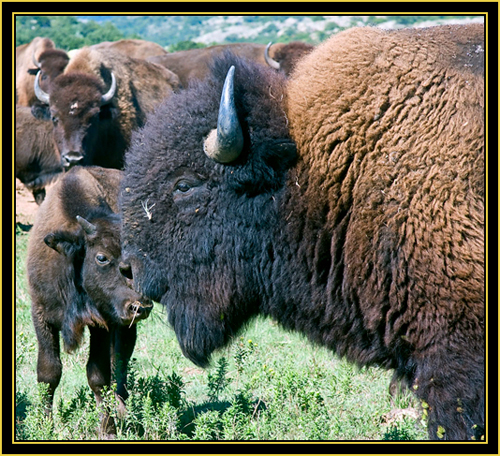
|
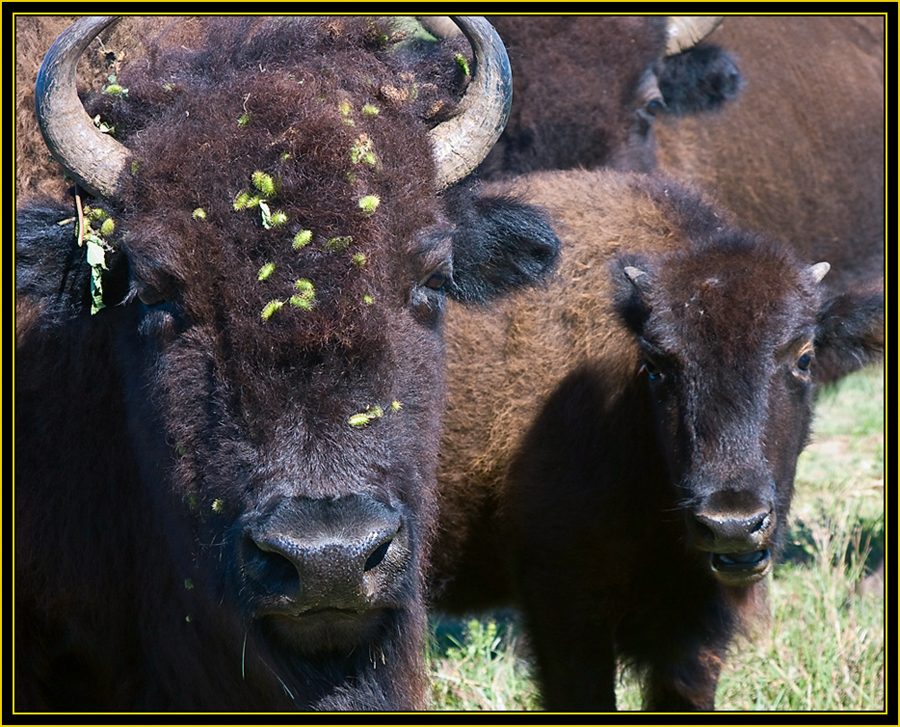
|
|
I was aware that gaining access to the special use area of the refuge was a privilege – as Rob would put it, ‘going behind the fence’. This is true at any of the multiple refuges where I’ve photographed of course - each has a particular beauty and eloquence. As we traveled along
in the striking panorama of the Wichita Mountains without anyone in sight, I recognized what an honor it was to be here. This refuge is large… it would take a good
deal of time to become familiar with the many different locations to know where a particular hot spot may be for birds or other wildlife. I’m always on the lookout for bird photography opportunities and I was telling
Rob that I didn’t think Oklahoma had any birds around in late September, at least none that were close… At right is Rob’s image of the truck on the gravel road at one of our stops. The 600mm lens and flash extender can be viewed with the tripod extended in the bed. The camera on the tailgate is my Canon 5d with a 400mm f/5.6L lens mounted. You can see the over-the-shoulder strap I use in the field clamped to the camera – I never employ a neck strap for varying reasons. I was in the grass taking exposures with the Mark III 1Ds camera on a tripod. See that bag in front of the tailgate that looks like an oversized lunch bag? I’m not certain what Rob had in it but don’t be fooled – it contained no food or water that I ever viewed… Photography 'Behind the Fence' |

|
Color on the Prairie...


|
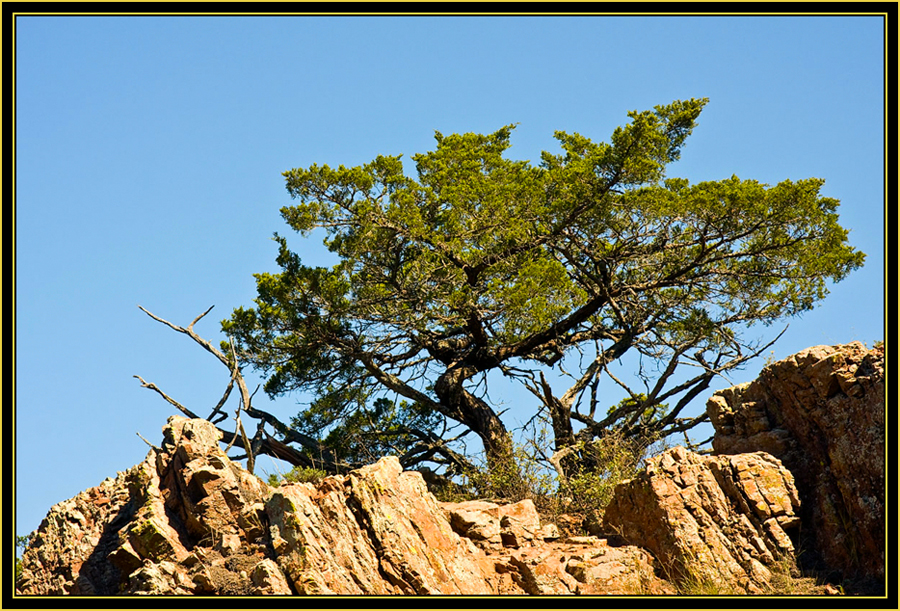
|
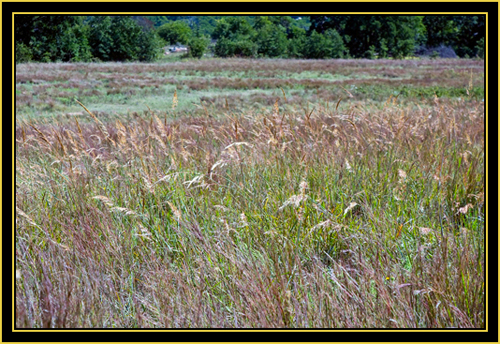
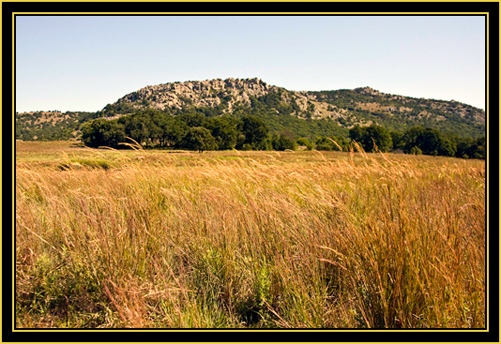
|
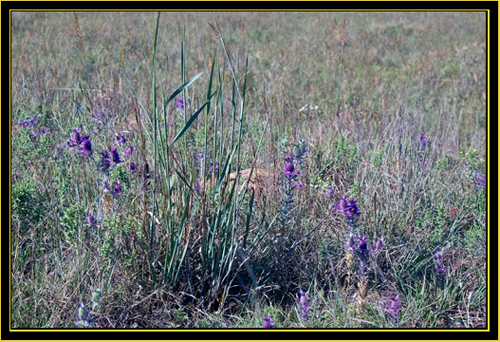
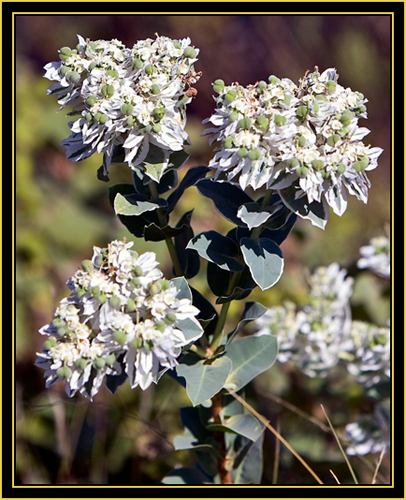
|

|
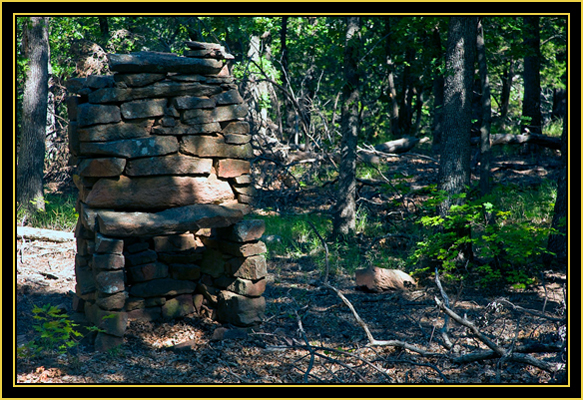
|
After a time we traveled into an area with woods on either side of the road. Rob mentioned that he knew there was a stone hearth in this area, the sole remnant of a former homestead and asked if I’d like to photograph it. So
we walked through the forest looking for the stonework, animals and whatever else we may find. He did fairly well locating the structure and I took a few exposures while thinking about what life must have like in the times
when the homestead was constructed and occupied. I told Rob of an account from when I was in the Florida Everglades earlier in the year… When the Everglades became government property the people who owned fishing camps on the
waterways were bought out - that is all except one family. According to a guide I talked with there is one fishing camp privately owned to this day. The owner at the time refused to abandon the camp on the water and the property remains in the
possession of his descendants after a decades' long legal action that is constantly being continued as they defend the case. I wondered what these homesteaders would have thought learning their land was now part of
a national wildlife refuge…
Homestead RemainsCanon EOS Mark III 1Ds handheld, 1/320 second at 105mm; EF24~105 f/4L at f/4, ISO 800 |
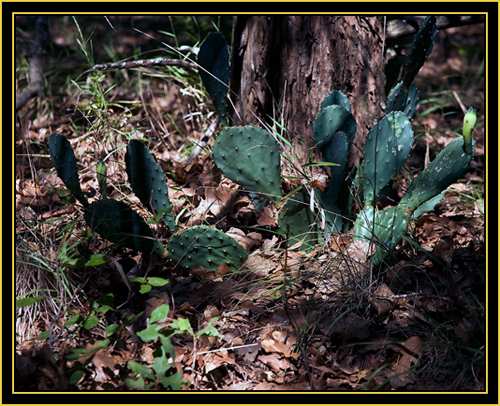
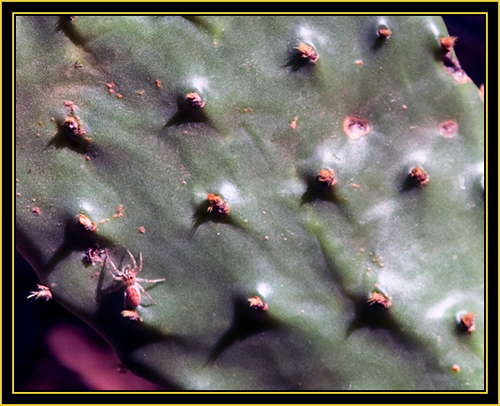
|
As we drove through the trees we started seeing a good deal of butterfly activity, particularly Monarchs but others as well. We decided to take the time to pursue some of these photographically. It was hot outside
in the open and the sun was harsh – perfect weather for these creatures to fly. But it wasn’t just butterflies we were on the lookout for. There were a plethora of insects flitting about we could see – we
planned to obtain images of as many as possible.
Fly on LeafEOS 5d, 1/800 second at 100mm; EF100mm Macro f/2.8 at f/6.3, ISO 640 |

|
Some Refuge Butterfly Views



|


|

|

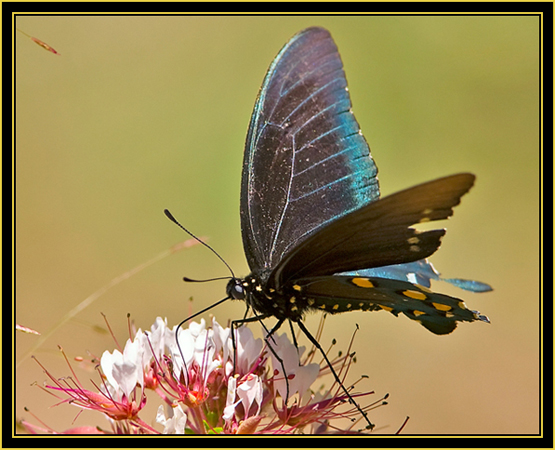
|
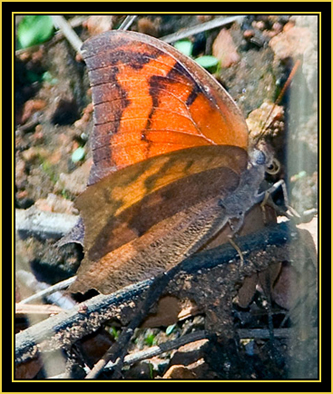
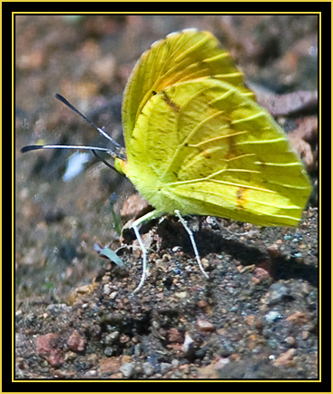

|
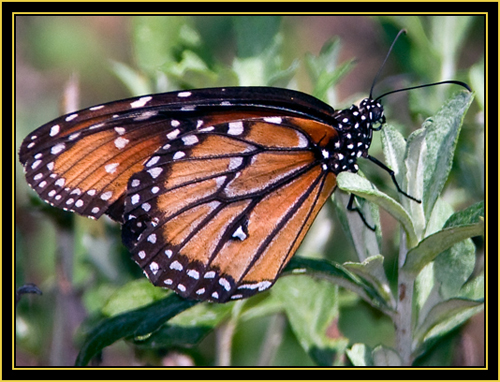
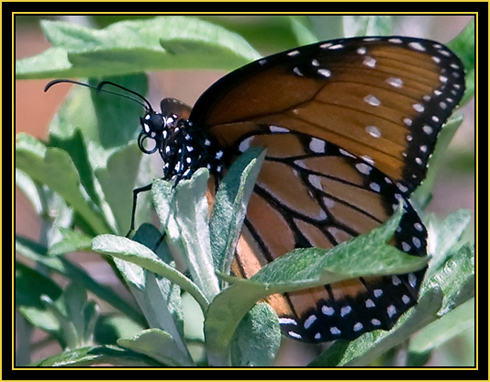
|
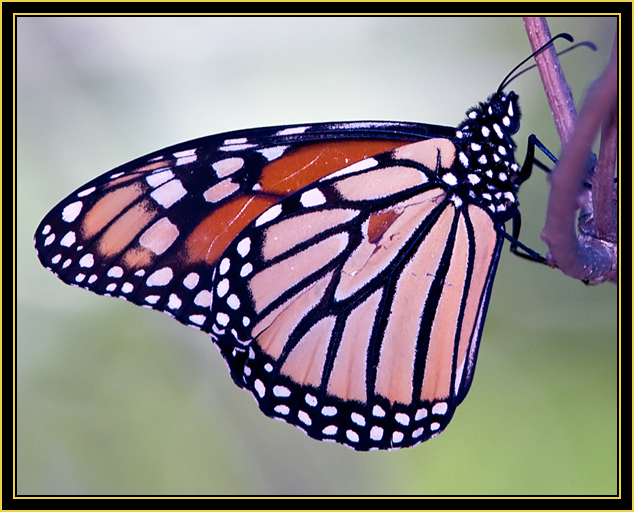
|
Above is a sampling of the butterfly images from the day but there are others in the shoot archive. One thing about web display is you have to significantly compress and reduce images for uploading – the photograph
at left is a good example of this… There were many Monarchs flying in the area where this shot was taken. I waited until one got into a more or less perfect position because I was seeking to obtain one pristine shot. In
my view this was it as far as I’m concerned. The Monarch landed in a tree just above my eyelevel. I was shooting at the longest practical focal length I could obtain, 840mm and was so close to the subject I had to pull the
tripod back in order to obtain critical focus. I had my flash & extender ready to add fill flash to make the colors pop. The butterfly wasn’t frame-filling at twenty-feet away, but the image scale was excellent. Viewing this shot one would think its okay or whatever, however, picture this
image printed at a resolution of 360 pixels per inch and a 16” X 24” ink size – the resolution of the 1Ds camera is stunning and this image would do it justice. I most likely would not print a Monarch shot that large but the point
is I could if I chose to do so. Just about any image can be displayed on the web – creating a nice print from the same file is a different matter entirely…
Monarch ButterflyCanon EOS Mark III 1Ds on tripod, 1/320 second at840mm; EF600 f/4L + 1.4X at f/6.3, ISO 640 with flash |
Continuing along on our quest for photographic opportunities we came to a small pond and stopped to investigate. We noticed a lot of dragonfly activity – yes indeed, one of my favorite subjects… It didn’t take long to figure out that few if any of the dragonflies were perching. Some species almost never
stop flying during the day; they stay on the wing as these 'lions of the air' wreak havoc on the insect population. Rob called me over to have a look at some commotion near the water’s edge where grass and some plantings were located. Yikes I thought – we’d hit the mother lode of damselfly activity… There
were many damselflies in this area, most in view appeared to be Familiar Bluets (Enallagma civile) which are larger then many species I’d photographed but generally much smaller then dragonflies. This Bluet species averages between 29 and 38 millimeters – 1.141 to 1.496 inches in length – not large by any measure.
I was reluctant to take the 1Ds camera off the long lens because I didn’t know what else we may see around us. The wind was up enough to be problematic going to a straight macro system so I elected to shoot this area just the way I was set up at 840mm.
Familiar BluetCanon EOS Mark III 1Ds on tripod, 1/800 second at 840mm; EF600 f/4L + 1.4X at f/8, ISO 640 with flash |
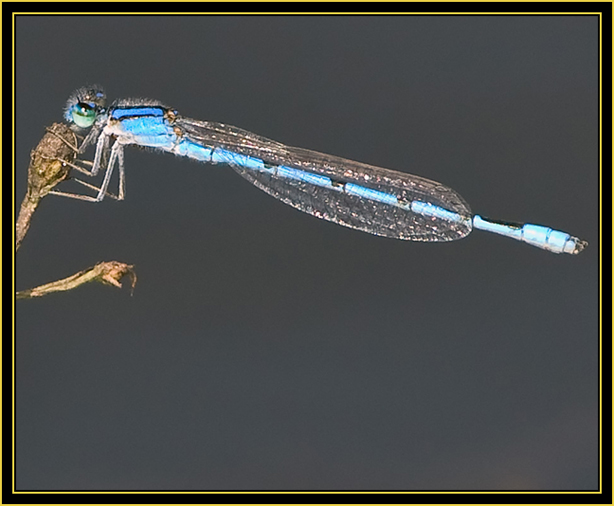
|
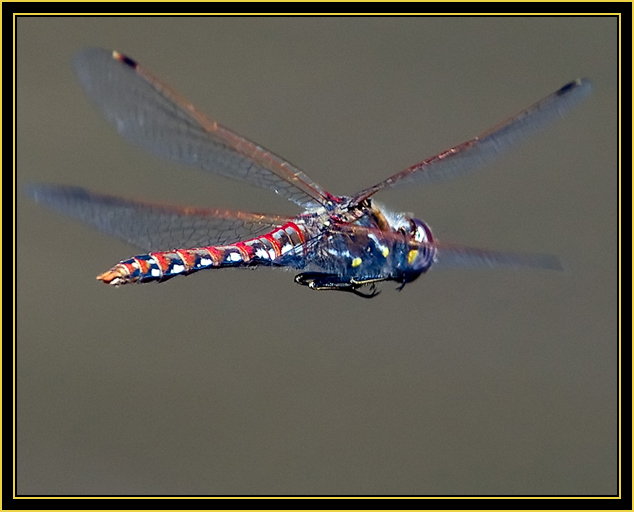
|
During the course of the day I’d learned that Rob is a real asset to take the field with. Besides being exceptionally knowledgeable & up for just about anything he has great eyes and a propensity for locating various
subjects. I’d be lining up a shot and he’d be seeking out another subject – we worked well together in this fashion. I kept seeing dragonflies skimming the water and every now and then they’d hover. I explained to
Rob that I thought shooting dragonflies on the wing was a worthwhile pursuit and afterwards I lined up the lens to achieve a neutral background to give this a try. This is one type of shooting where few if any exposures
will end up in the final as ‘keepers’. Following a flying dragonfly is no simple task done handheld or on a tripod. I urge everyone to give it a try to learn how well you can do… Rob and I had been talking photography
all day and I had him looking through the cameras and learning about exposures, shutter speed, etc. He got right into the flying dragonfly effort and proved to be an excellent spotter. With a good spotter you don’t
have to move your eye from the viewfinder often. You adjust the lens to retain the subject in the field of view via verbal communication as the spotter tracks the movement of the subject.
Find at left one of the
better images from this foray…
Variegated Meadowhawk in FlightCanon EOS Mark III 1Ds on tripod, 1/1250 second at840mm; EF600 f/4L + 1.4X at f/8, ISO 640 Find below several more exposures on the same species taken at this time. I also shot some handheld exposures that came out okay with a smaller image scale and were not as pristine as these. |
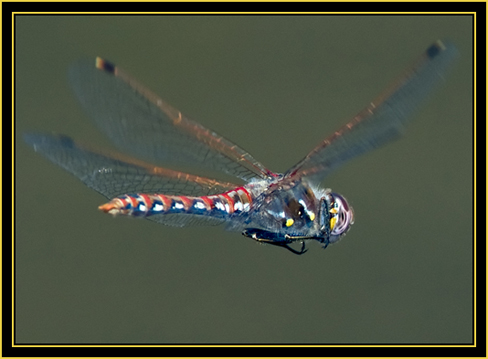
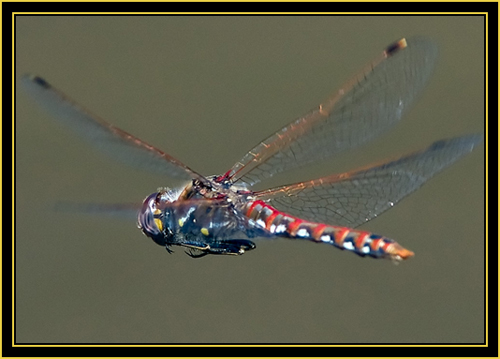
|
At the Pond - Damselflies at 840mm...
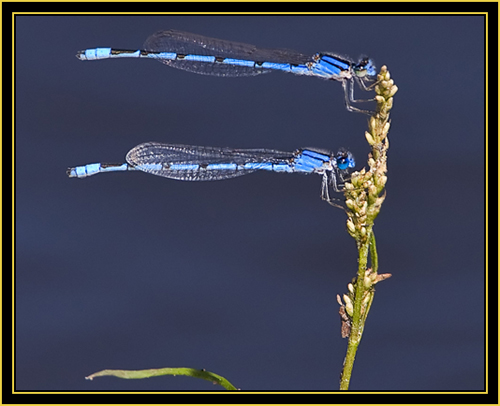
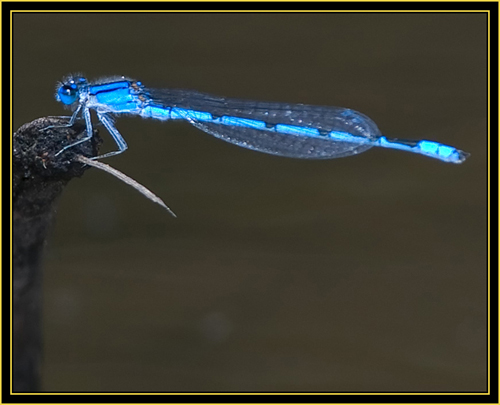
|
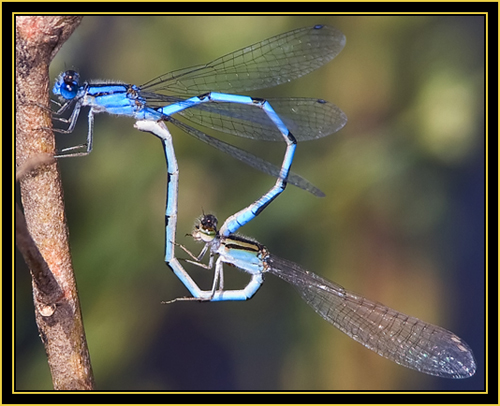
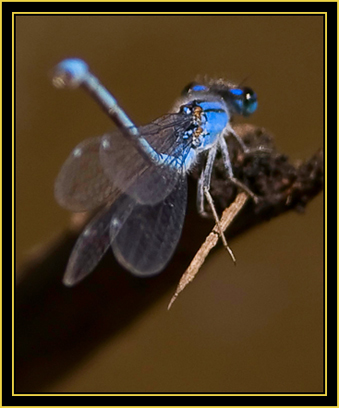
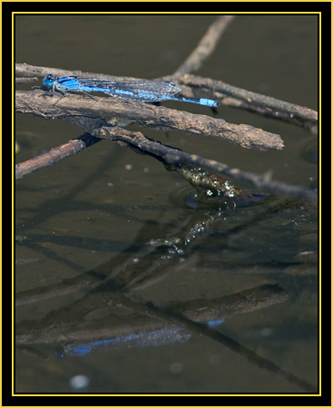
|
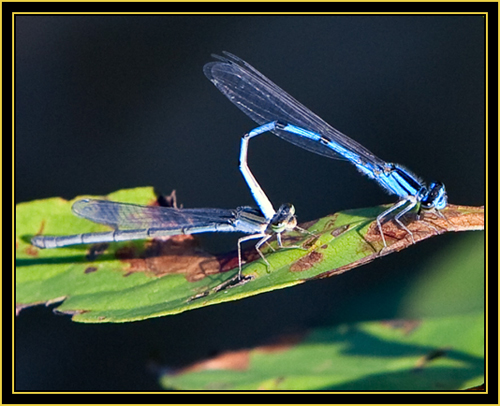

|
There was a lot going on at this stop and I can’t say that I recalled ever seeing so many damselflies in one place in my experience. We just happened to hit this spot at the right time I suspect. But there were also other creatures and scenes of beauty around us. I’ll post some of these below before moving on...
Familiar BluetsCanon EOS Mark III 1Ds on tripod, 1/1000 second at 840mm; EF600 f/4L + 1.4X at f/6.3, ISO 640 |
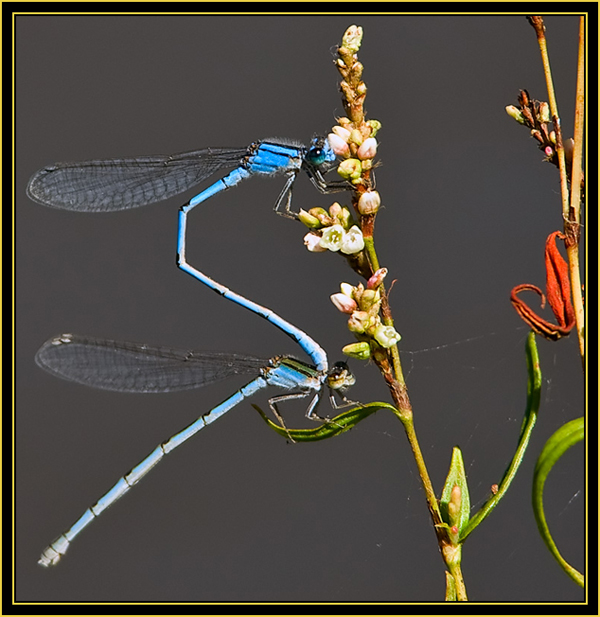
|
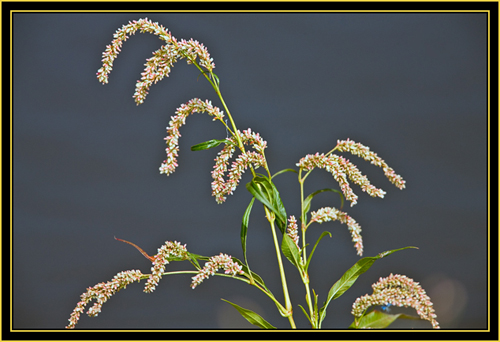
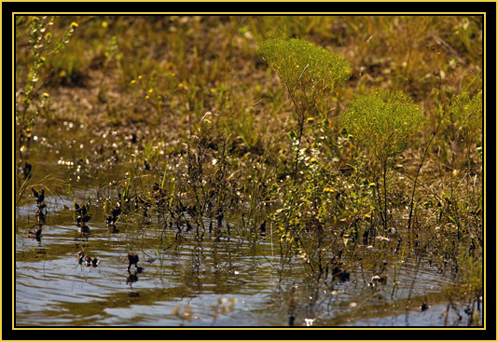
|
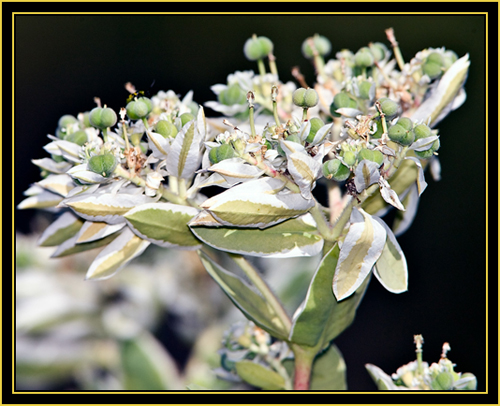
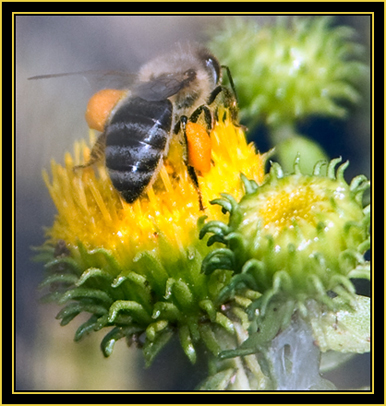
|
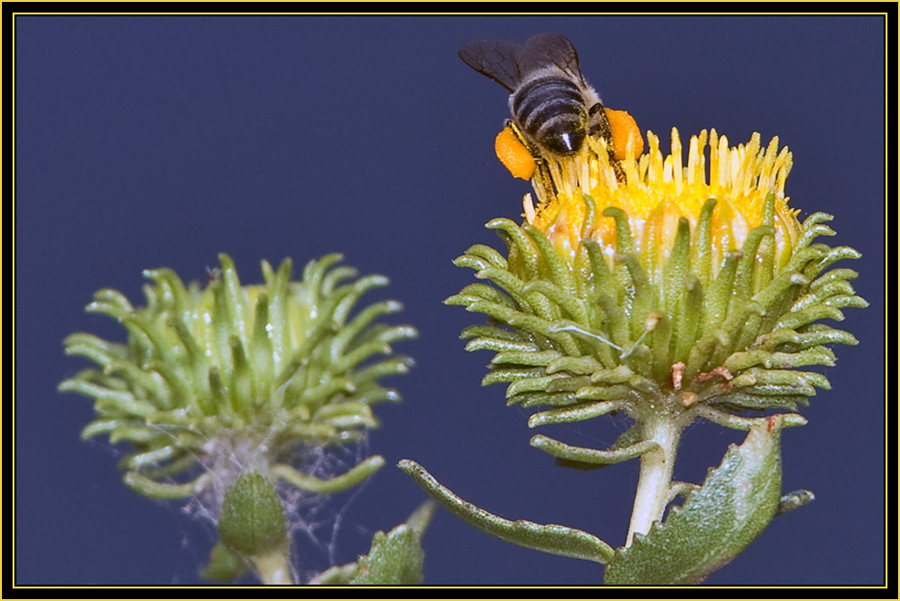
|
Grounded Variegated Meadowhawk
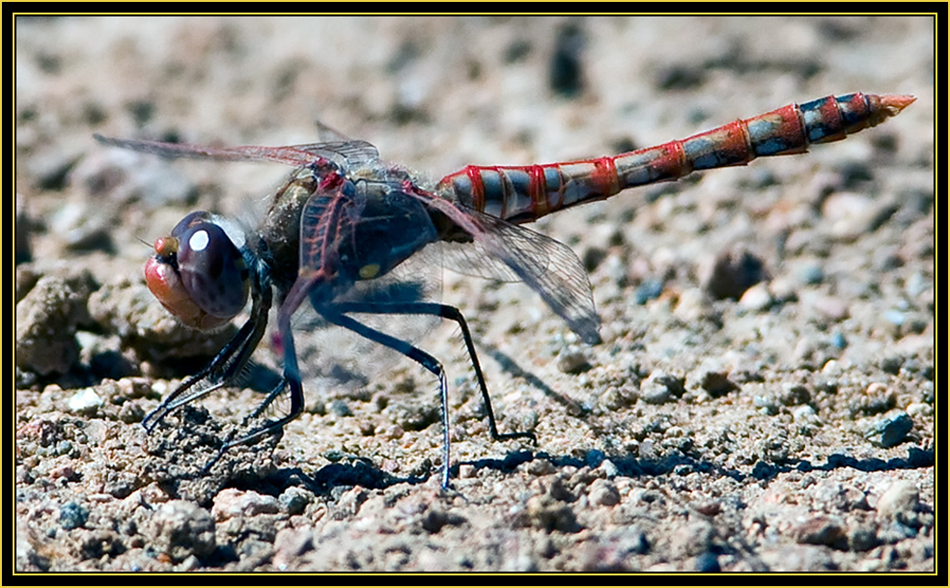
|
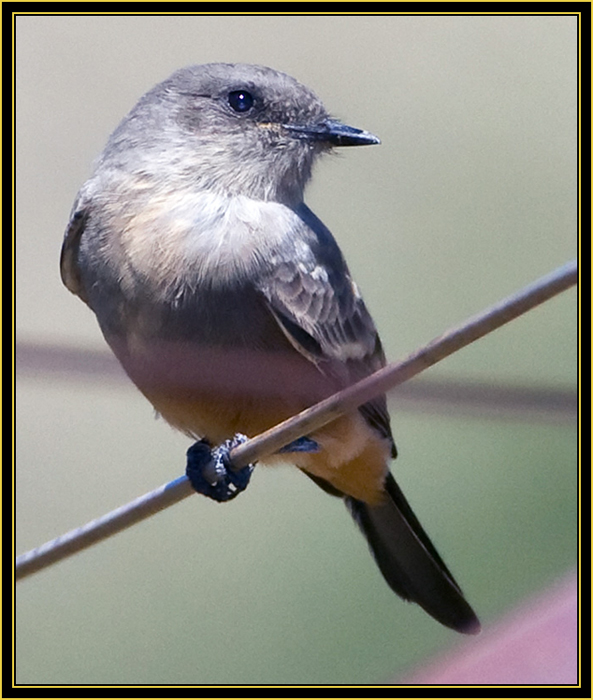
|
We packed the camera gear back on the truck and moved on to further adventures... There was so much to see and I viewed opportunities all around me – everything was worthy of a photographic effort, all I
had to do was step out of the vehicle. We came around a curve in the roadway with a fence on our left. I viewed a single bird moving around the fence and surrounding area. This in itself isn’t remarkable although I was beginning to wonder about the lack of birds in Oklahoma predicated upon what I’d viewed so far, but I didn’t recognize this species and that caught my attention… I indicated to Rob I’d like to photograph this subject, so I walked away from the truck attempting to make an approach. As often happens the bird kept moving down the fence away from me so I wasn’t closing the distance as I turned the corner. Forget about a stealthy advance here – there was no cover and short of crawling across the gravel road this couldn’t be accomplished. You can trust when I state I have crawled around plenty in my search for close composition & good image scale but I was becoming tired and had little inclination to do so now even if it would have worked. I took a series of shots on this bird but most displayed movement and were deleted. This was an exposed area and the wind was whipping through by now. The image at left was the best of the group I obtained… Say's Phoebe - The Bird on the Fence...Canon EOS Mark III 1Ds on tripod, 1/1000 second at 840mm; EF600 f/4L + 1.4X at f/6.3, ISO 640 |
On the opposite side of the road away from the fence I spotted an American Kestrel in the remains of a dead tree, the only such cover in the area. By now Rob was out of the vehicle as I walked back with the
tripod taking a few insurance shots along the way. This species, the smallest of the falcons, is territorial and have a wide ranging 'comfort zone' - they don't like intrusion on their turf. I figured that if I could get close and stay low in the grass the bird would return to this
favored perch where I’d be in a perfect position for an exposure. While I made the approach Rob tried to locate the bird, the thought being if it was still around and was flushed it may return to the tree. This
didn’t happen in the end result and we moved on after twenty minutes or so. Besides this disappointment the wind caused the insurance shots I did obtain to be less sharp then I would have hoped so I never got a decent kestrel
shot from the day. I do have some excellent shots of this species in my archives so it was far from a total loss...
Seeking out the Kestrel...Canon EOS 5d handheld, 1/640 second at 70mm; EF70~200 f/2.8L at f/9, ISO 640 |

|

|
While near the areas of water we’d spotted several turtles at a distance. All I can say is that turtles in the Wichita Mountains are skittish – no matter how far away we were when exiting the truck they would immediately
take to water and disappear. We came to a larger body of water hoping to find some and I was amazed – there were some ducks in sight.
Turning, I commented to Rob facetiously that there were at least four species of birds in Oklahoma… Through the binoculars we identified the group as Blue-winged Teal. Of course we hardly moved from the truck when the group took flight. I
quickly got the tripod out to photograph the group but none of these images turned out well at 840mm as I couldn’t obtain critical focus due to interference with the tree line behind. Fortunately the group came around
again. I’d moved away from the tripod by this time but had the 5d & 70~200 lens slung so picked it up with the lens racked out to 200mm and took a few shots… The best of the group can be viewed below.
Rob's View of Kiro on a Turtle Hunt |

|
This stop proved to be fortuitous as far as turtles were concerned. There were multiple specimens sunning alongside the water. I walked down to the water stopping to take some insurance shots along the way because I
figured the turtles would skedaddle momentarily. I recognize we’re talking abut turtles here – it’s not like some rarely seen or obscure creature, but I was on a mission by now and wanted to photograph at least
one before day’s end. We viewed at minimum two turtle species at this stop although we could not identify the second. This turtle can be viewed below. I should point out that an ‘insurance shot’ is an exposure one takes during
an approach to make certain you have some example in the photographic archive on a subject, even an exposure taken too far away, just in case it flies, runs, crawls, creeps, dives, hides, etc., before you can obtain a close approach as is far too often the case…
Red-eared Slider |
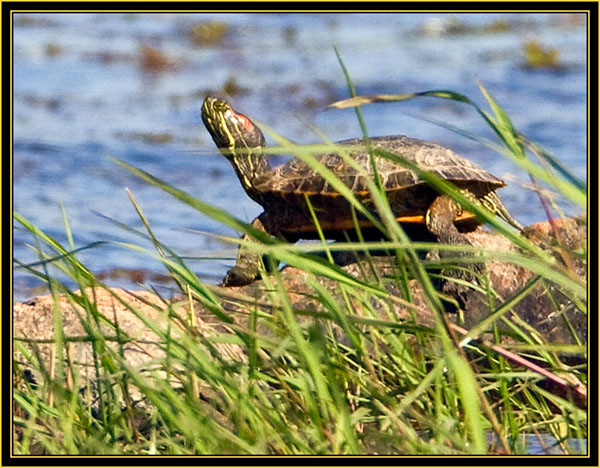
|
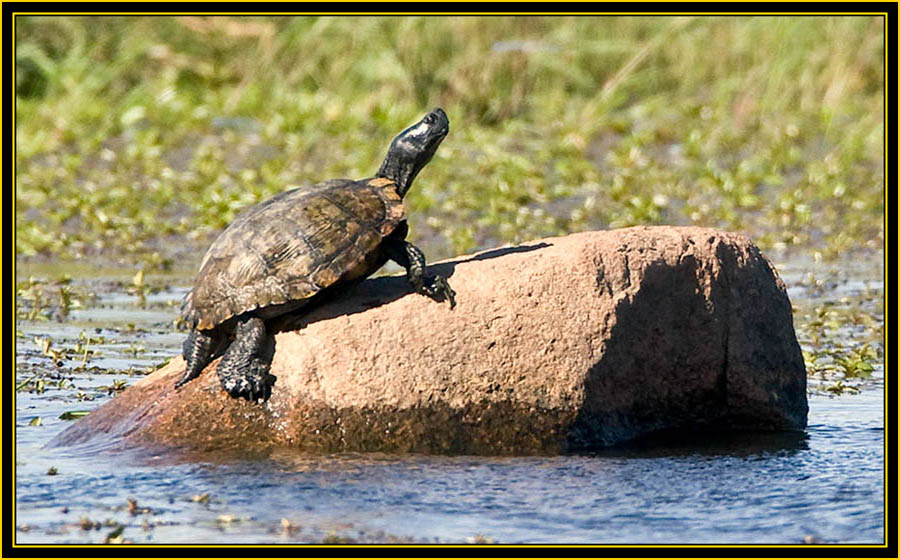
|
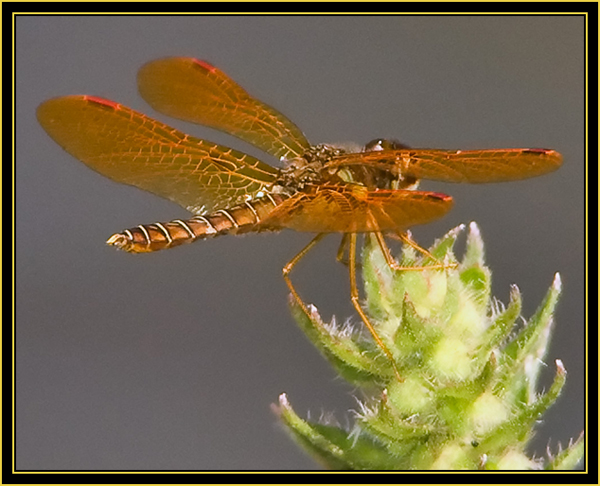
|
I spotted some dragonfly activity and went over to check this out. I could see other things to investigate as I looked around, cactus and other plants and as always, neat looking rock formations.
Eastern AmberwingCanon EOS Mark III 1Ds on tripod, 1/1250 second at 840mm; EF600 f/4L + 1.4X at f/6.3, ISO 640 with flash |
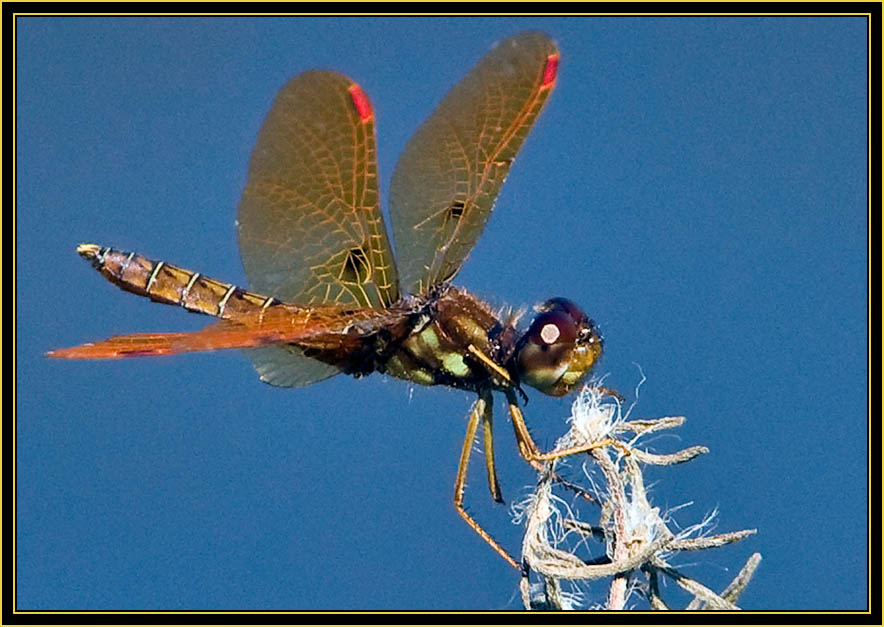
|
Kiro Photographing in the Field
Camera - Canon EOS Mark III 1Ds; at the time of this writing this is Canon’s top line professional body and in my estimation a phenomenal device; Promaster Flash Extension Cord – used to get from the body to the flash when employed off-camera – you always want to have a least one spare on hand as the connections can get worked hard to the point of failure when carrying the tripod; my hand is hiding the Canon EF 1.4X Extender which increases the focal length of the lens when applied – this is only about 1.5 inches wide in the image train. The 1.4X extender will cost one stop of light however; a 2x extender would be two stops; in my application below, the lens goes from f/4 to f/5.6 when shot wide open; lens – Canon EF 600mm f/4L - a wonderful lens with image stabilization & excellent autofocus capabilities; The flash head is Canon’s 580EX with a Better Beamer Flash Extender attached. The lens is attached to a Wimberley Head Version II which when balanced properly is a joy to use. I own lens plates, camera body frames and accessories from a California firm, Really Right Stuff, as well as from Wimberley – both are excellent companies. The tripod is a Gitzo GT5530s – a carbon fiber, heavy duty tripod rated to support 55 pounds. The equipment and mountings are similar to those used in my astronomy pursuit, just more light duty. I’ve learned in astronomy that rigid support systems are critical to success and have carried that view into daylight photography. Collectively the system weighs in at just over 27 pounds and I carry it in the field nearly all the time – unless I have Rob along to help… If you'd be interested in learning more about my equipment and lens choices I refer you to my web article: My Canon Photographic System.

|
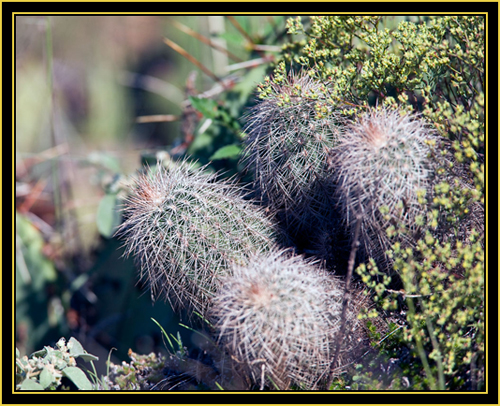
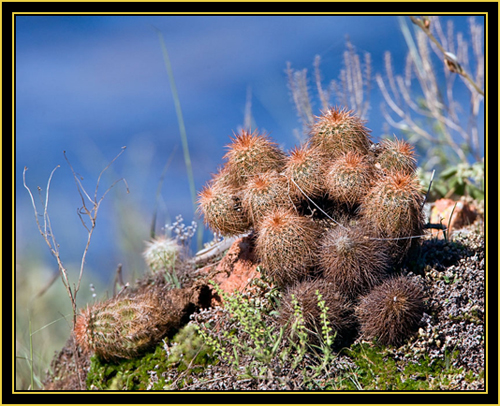
|
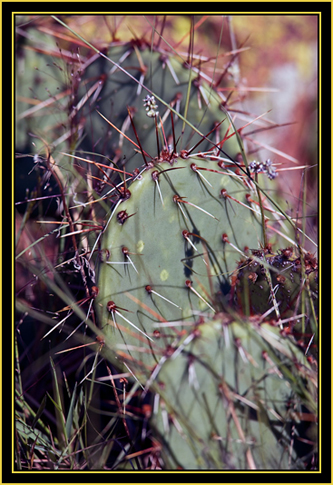
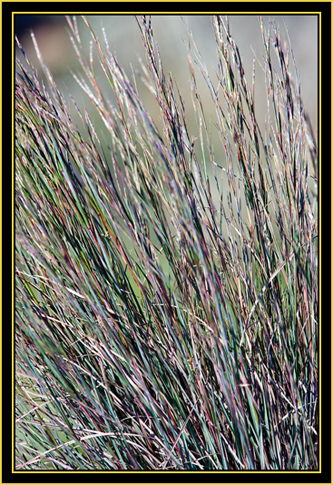
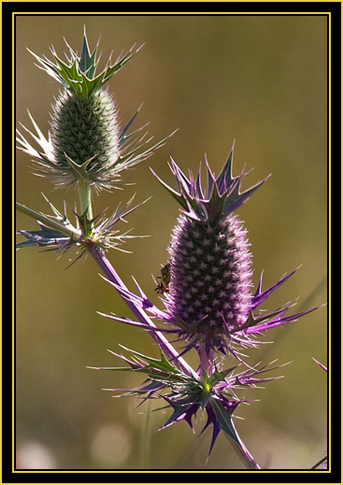
|
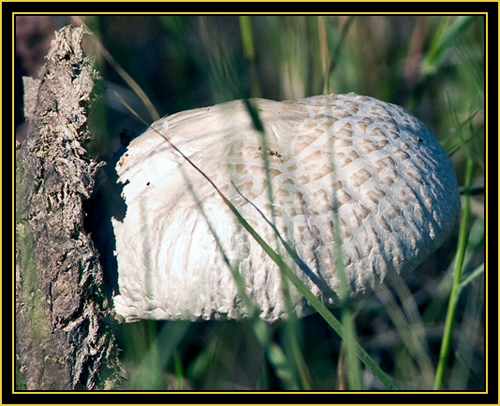
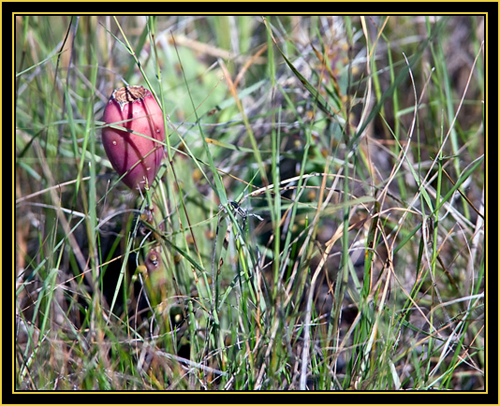
|
We discussed the various subjects digitally captured during the day. The exposure count was getting up there although I wasn’t concerned about filling the many compact flash cards I had available in one day. I did express a regret that with the many
grasshoppers around I wasn’t able to get really close on one photographically. We did attempt to do this on several occasions and Rob pointed some out here and there but they don’t hang around long if you express an interest in them. We were near the gate
and walking around the truck when Rob called me over. When I viewed what he had going on I came over and took the shot as seen at right…
Rob's 'Catch of the Day'Canon EOS 5d handheld, 1/800 second at 200mm; EF70~200 f/2.8L at f/6.3, ISO 640
|
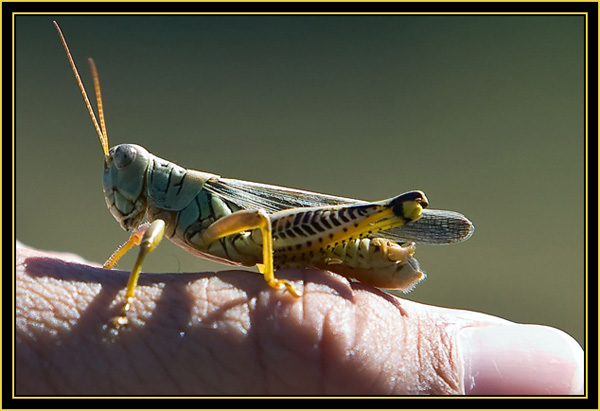
|
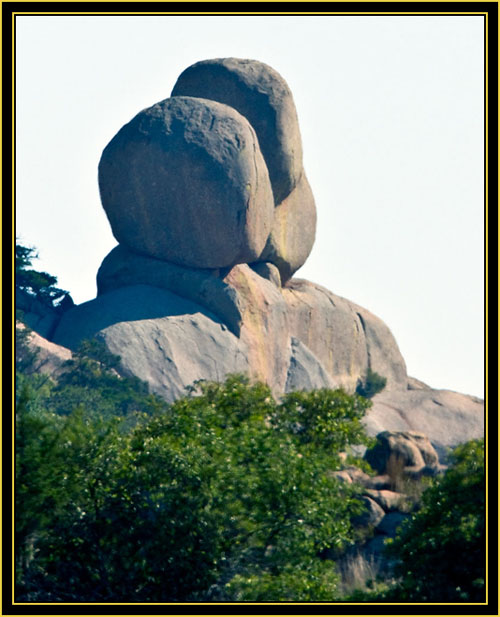
|
We were preparing to pass through the gate, re-entering the real world after many exceptional hours in the stark beauty of the refuge landscape. It was nearly 5:00 PM; we’d been up for over twelve hours, most of it spent in
the refuge and there was plenty of daylight remaining. I can go a long time with little or no food but I don’t do as well without water in such warm weather. The Oklahoma sun & wind were dehydrating me in combination even in September. We
looked at the time because the plan was to catch the sunset. Sunset wasn’t until 1922 – 7:22 PM – we had a couple of hours to go. When Rob asked what I thought we should do next I stated unequivocally – find a store. I didn’t know what I was asking
I suppose… There’s no Circle K or 7-11’s remotely close to where we were. I won’t go into great detail about our fairly extensive quest for water, but we ended up driving into the smallish resort town of Medicine Park. There were shops,
some open - some not, activity and people walking about but nothing like a convenience store. Rob asked around to no avail. At the end he went into a restaurant to check. They must have taken pity on him because he returned to the truck
with two Styrofoam cups of water. I was pleased with this result because the next step would be to immerse my head in Medicine Creek running through the town and drink 'til I popped. I should point out that I
got the impression Rob thought this all a bit odd – I doubt he was thirsty at all and probably couldn’t figure out why I should be... He wasn't hungry, thirsty or tired as far as I could tell...
Apple & Pear...Canon EOS Mark III 1Ds on tripod, 1/1600 second at 840mm; EF600 f/4L + 1.4X at f/8, ISO 640 |
Upon conclusion of the water quest we headed back into the refuge grounds to exchange vehicles in preparation for sunset. We had a plan to meet Ms. KK, Rob’s spouse, at Mount Scott, the highest point of land
around. Ms KK is an educator and she was going to drive out from Lawton once her workday teaching was concluded to join us for the sunset session. We had some time before heading up the mountain and used it to good advantage. We
viewed a group of Wild Turkeys in the woods and I got out of the truck in an attempt to photograph them. It was difficult shooting in the woods with dim light and the birds were quickly moving away. These images were okay
but not what I would like to archive. And there was always the stunning landscape all around us to capture through the lens. Rob pulled into Lake Elmer Thomas and we got out to investigate.
Refuge Water View - Elmer Thomas LakeCanon EOS Mark III 1Ds, 1/500 second at 45mm; 24~105mm f/4L at f/16, ISO 1000
|
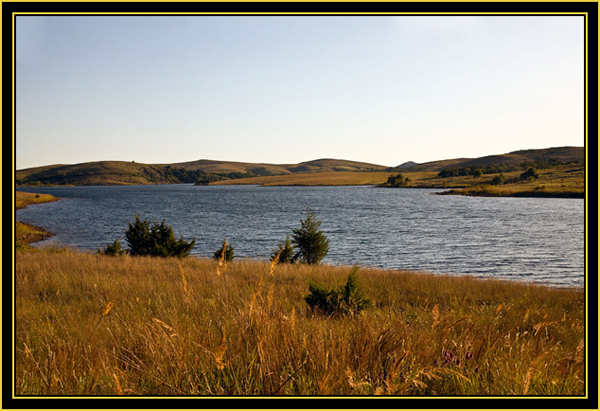
|
Clouds Over Elmer Thomas Lake
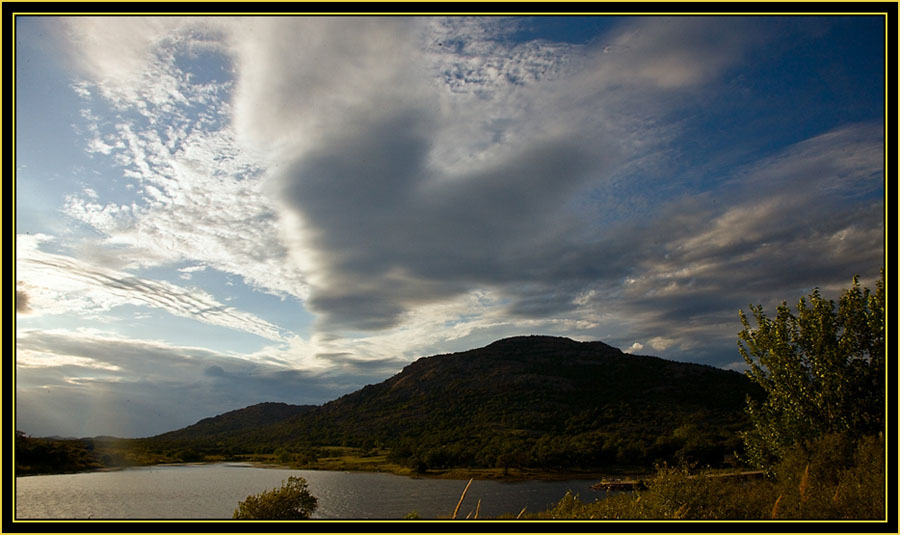
|
More Views Around the Lake...
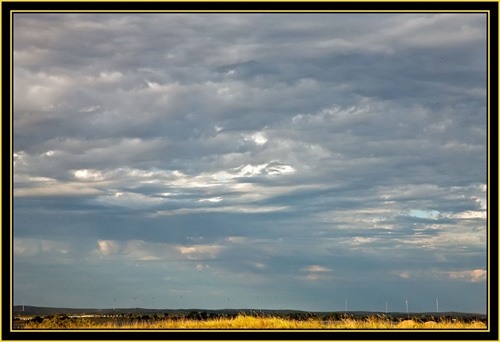
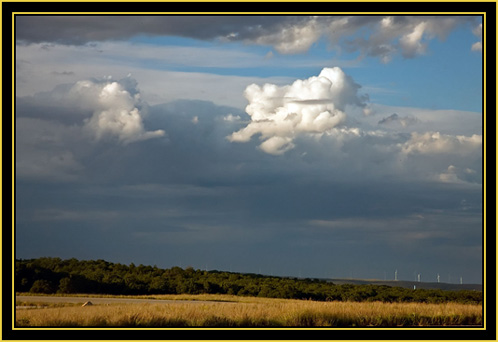
|
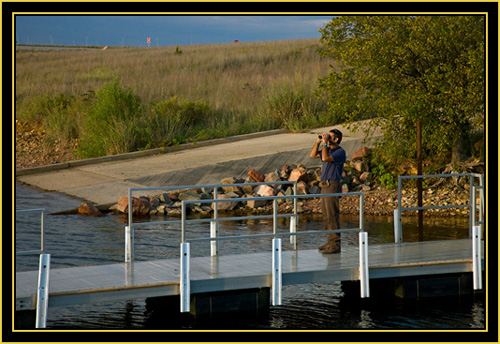
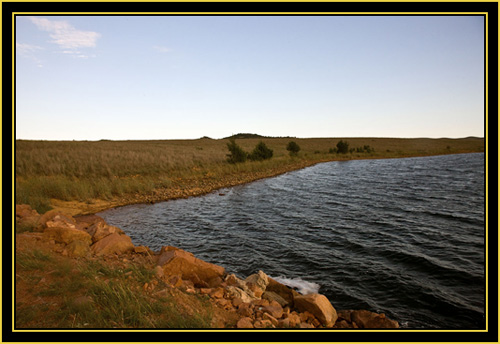
|
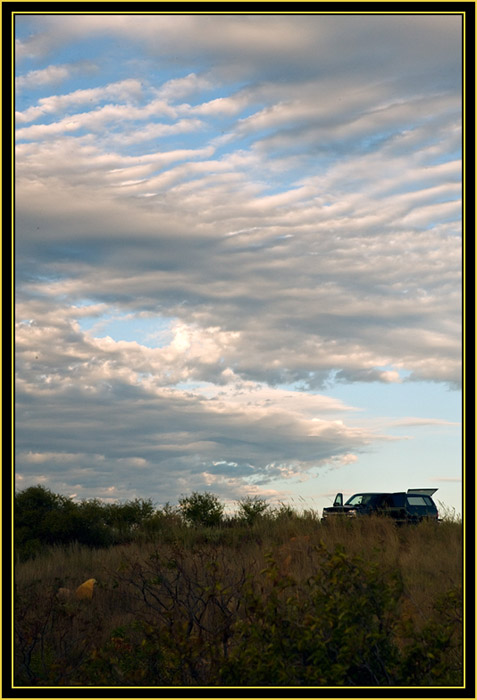
|
We checked the time and decided to drive up Mount Scott early enough to find where we’d wish to set up. There’s a meandering paved road to the top so this is a desirable spot for the general public
to visit at any time of day, especially sunset. This road is closed at nightfall for safety purposes and Rob indicated the refuge law enforcement officers often have to drive up to the upper parking area to get
people off the mountain. At 2,464 feet, this is the second highest mount in the refuge – I read that Mount Pinchot is twelve feet higher but is within the special use area and thusly not publicly accessible.
Kiro's Truck Under Big Sky... |
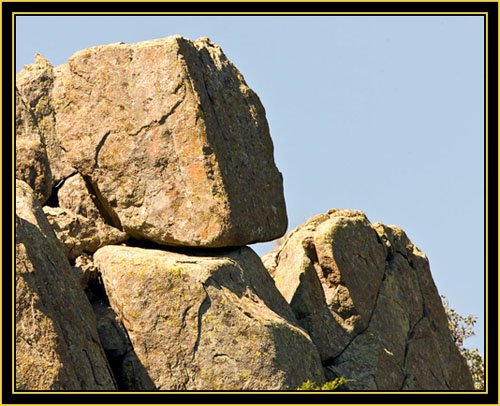

|



|
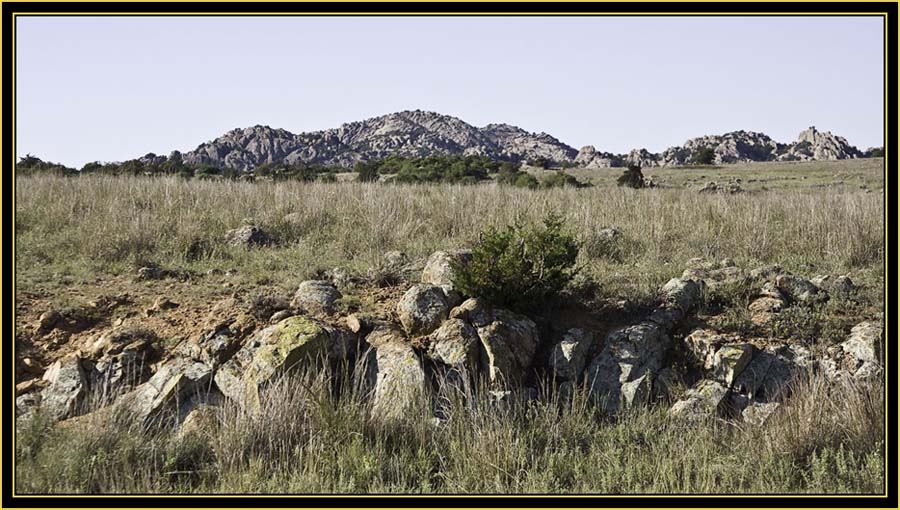
|

|
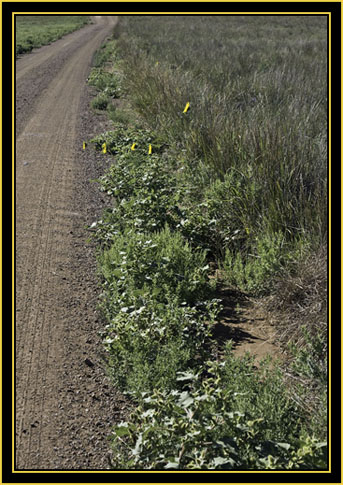

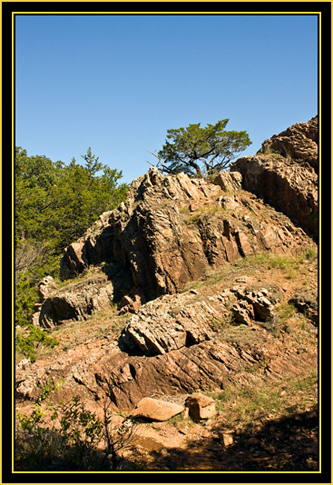
|


|

|
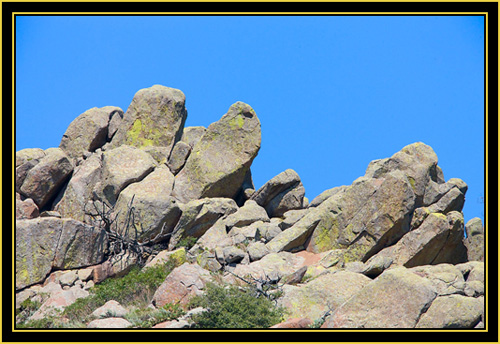
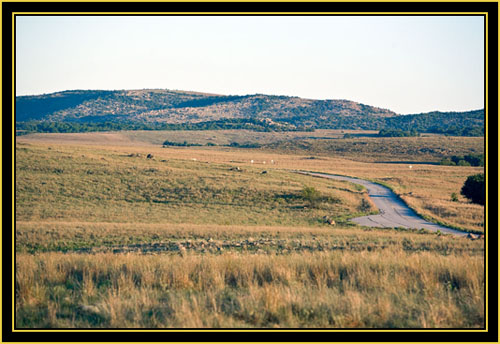
|



|
|
We scoped out the available turn-offs along the road, drove up to the top, turned around and started back down. I believe we ended up at the last turn off before the top parking area and I got the cameras ready as
we checked out the view. It was indeed superb and we were higher than the tree tops so we scanned around for birds and other subjects of interest. I’d noticed movement and turned to see a raptor flying. Seeing
this motion was a good thing because it was far below and I don’t know if we would have located this bird otherwise. I took multiple exposures of what was clearly identified as a Red-tailed Hawk through the
lens, not expecting much success from this distance.
It wasn’t long before we were joined by Ms. KK. She asked how the day had been and I related our many adventures and commented on all we had seen and done. And yes, the fact we didn’t stop for sustenance of any kind did come up as well as the ‘quest for water’. KK thought this extremely amusing and didn’t relent on Rob about it for the balance of the weekend. I did indicate it wasn’t his fault – I’m fully capable of taking care of myself – it was just that our schedule and such a long day precluded doing much in the way of better planning… Red-tailed HawkCanon EOS Mark III 1Ds, 1/100 second at 840mm; EF600 f/4L + 1.4X at f/5.6, ISO 1600
|
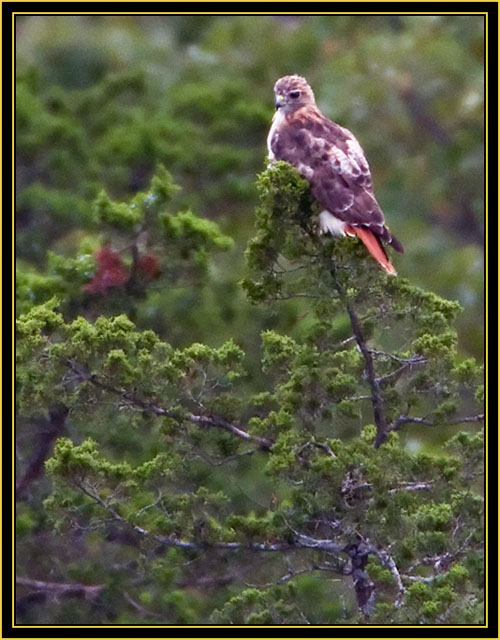
|
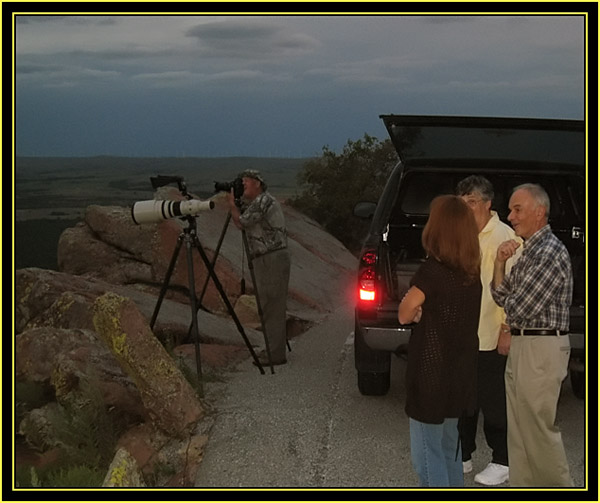
|
This is Rob’s image of our group at sunset. While we were watching for color in the sky we had some people stop by to chat. I showed them the hawk through the lens and KK answered questions about the area as they were from away – far away actually like Austria and Scandinavia I believe - one from each
location. Although back to in this image Ms. KK is in the foreground with the black blouse. I’m lining up a shot with the 24~105mm lens and 1Ds camera on a tripod. The 600mm lens remains trained on the Red-tailed Hawk but I've dismounted the camera. Our visitors are blocking the view of the truck's tailgate
but you could view the balance of the cameras and lenses laid out and prepared for use otherwise.
Visitors at Sunset - Mount Scott - Wichita Mountains Wildlife Refuge |
Wichita Mountains Views from Mount Scott
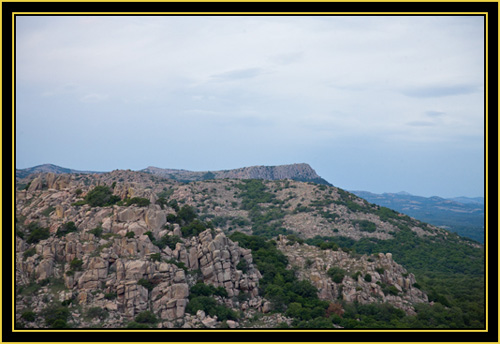
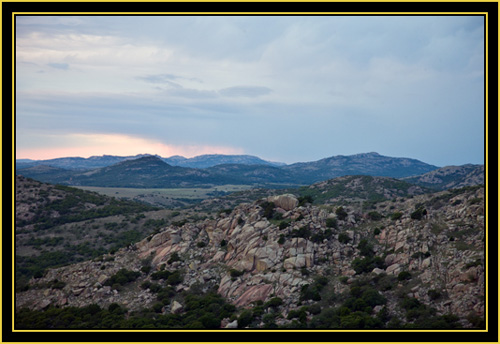
|
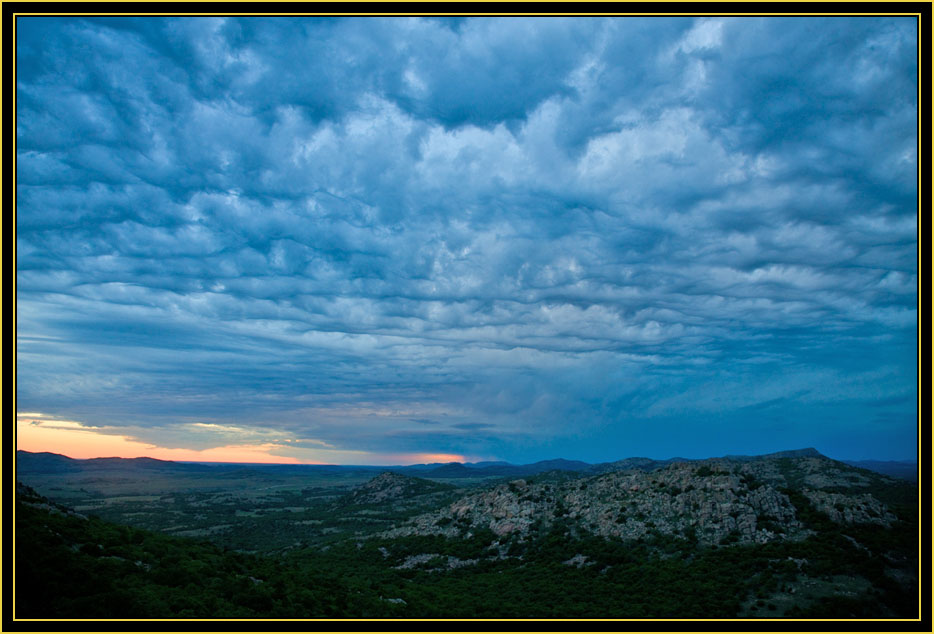
|
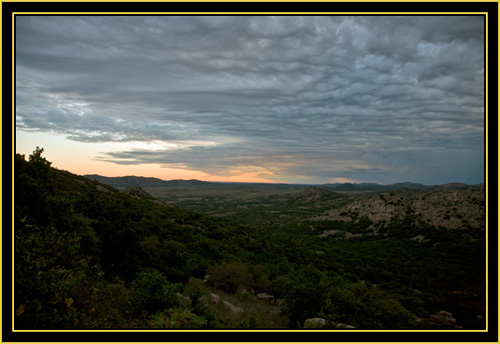
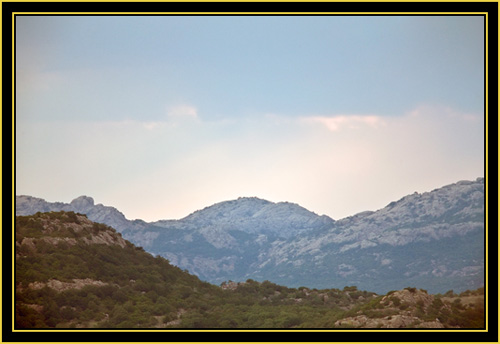
|
I’m not going to add much about our view of sunset – I’ll let these images tell the tale. The cloud cover prevented a shot of the actual disk of the sun dropping below the mountains
but I was after the sky colors associcated with this event and the clouds were helpful by adding illumination to the scene. It had been a long, tiring and wonderful day in the Wichita Mountains and this ending really capped off a remarkable experience…
Wichita Mountains SunsetCanon EOS Mark III 1Ds, 1/5th second at 70mm; EF70~299mm f/2.8L at f/8, ISO 800 with Electronic Cable Release
|
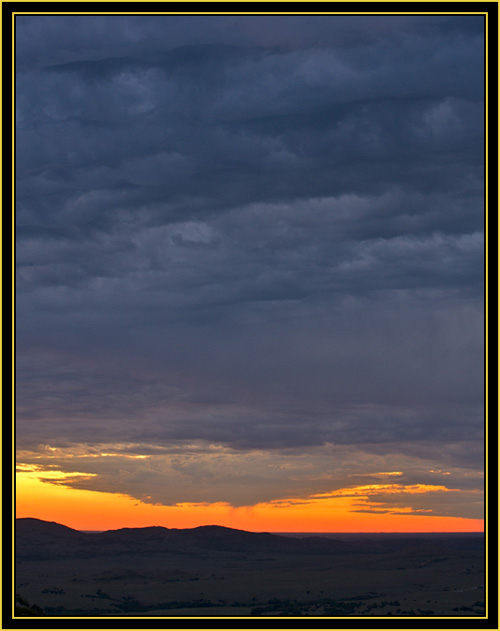
|
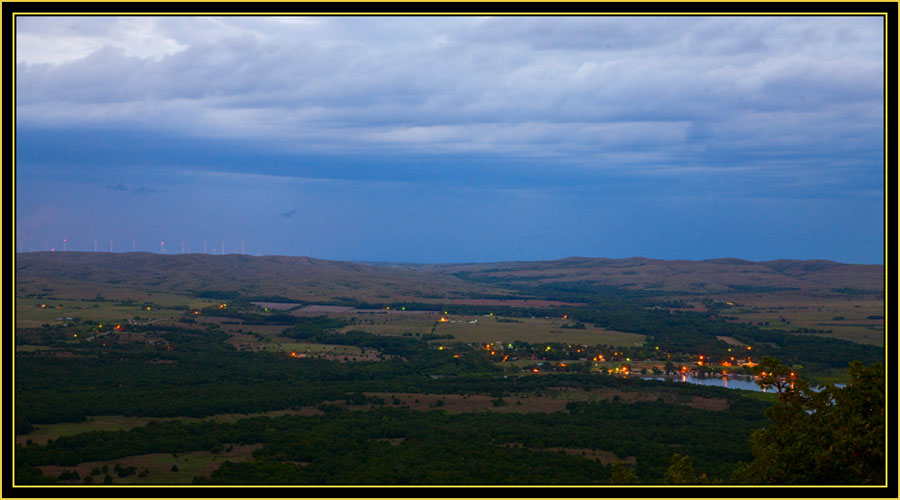
|
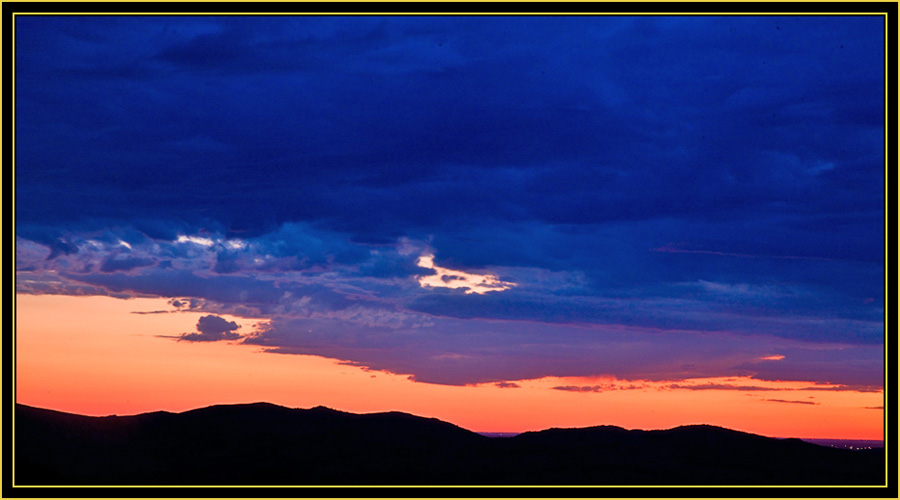
|
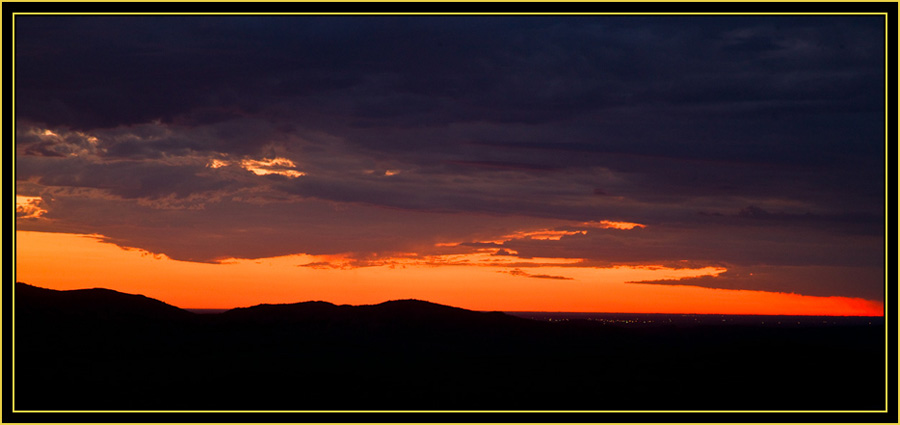
|
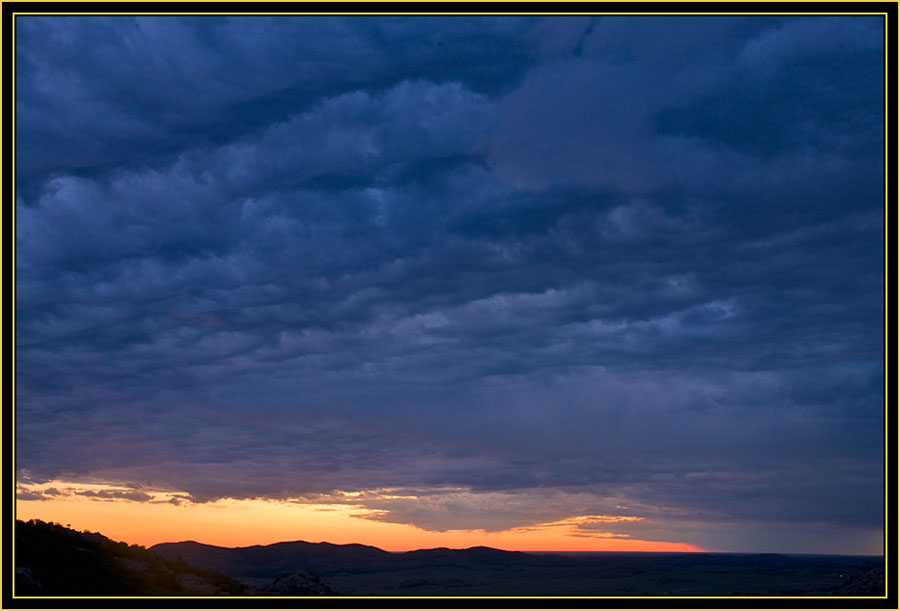
|
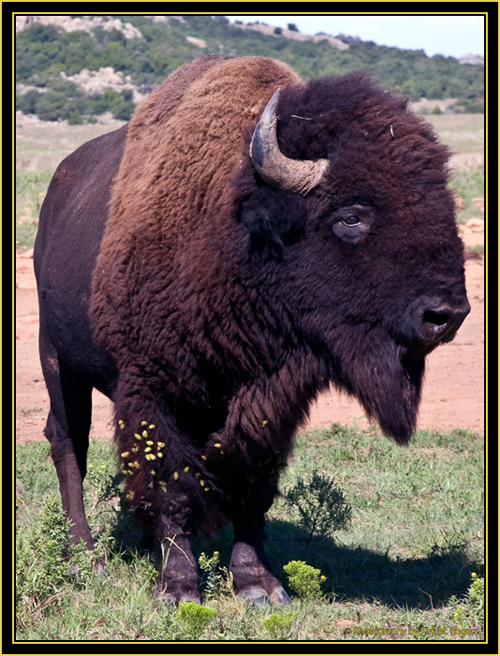
|
As we left Mount Scott Rob stayed with me in the truck - I didn’t know the area and nightfall was well established - this area really has dark sky conditions. We traveled back to Medicine Park for dinner at the 'Old Plantation', formerly a full service hotel now serving as a restaurant, which was quite good. The
community of Medicine Park is located near the primary entrance to the Wichita Mountains Wildlife Refuge. I read that it was Oklahoma’s first planned tourist resort founded in 1908. The area flourished growing from a single
army surplus tent with a wooden floor that served meals, had Medicine Creek nearby for swimming and limited campsites available to multiple businesses and services being offered to accommodate visitors from Oklahoma and
north Texas. The primary attraction to the area was the refuge and thousands flocked to the area on weekends and throughout the different seasons. By the 1930’s Medicine Park became known as the ‘Jewel of the
Southwest’. The hotel was constructed in 1910 and consisted of a three-story structure owned by Oklahoma Senator Elmer Thomas who literally founded the town (remember Rob and I visited the lake named after the
Senator?). The original building was constructed with cobblestones and several wood frame additions have been added since that time. The facility did well and in the ‘Roaring Twenties’ when Medicine Park was ‘the’
location to frequent by the rich, famous and societal elite, it thrived. KK had lived in this area all her life and regaled us with stories of the facility when she was growing up and the many changes to the
place. By now I had an appetite having made it through the day dining on two apples so I was ready for a good meal. I’d also received a multitude of insect bites during the day and now was starting to itch. The prairie is full of chiggers and
other critters who must have truly appreciated having us in the area….
American Bison - Wichita Mountains Wildlife RefugeCanon EOS 40d, 1/320 second at 85mm; EF24~105mm f/4L at f/8, ISO 400 |
You may recall comments that Ms. KK viewed the day’s lack of food and water with levity… She indicated that I must think the worst of all of them – light rations, just enough water to sustain life, a sixteen - hour day photographing the refuge – bet I’d be happy to head
northeast when the time came… she was unrelenting towards Rob although I defended him in detail. KK had baked a cake and not long before Rob retired for the evening he decided to try some. At right is KK’s photograph of Rob happily consuming chocolate cake as I look
upon the scene with yearning. She stated this was typical of the day and asked that I post this image. So here it is Ms. KK…
KK's Photograph at the House - Kiro & Rob... |

|

|
